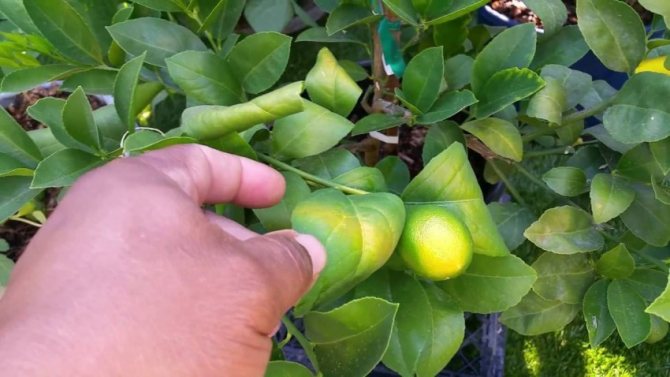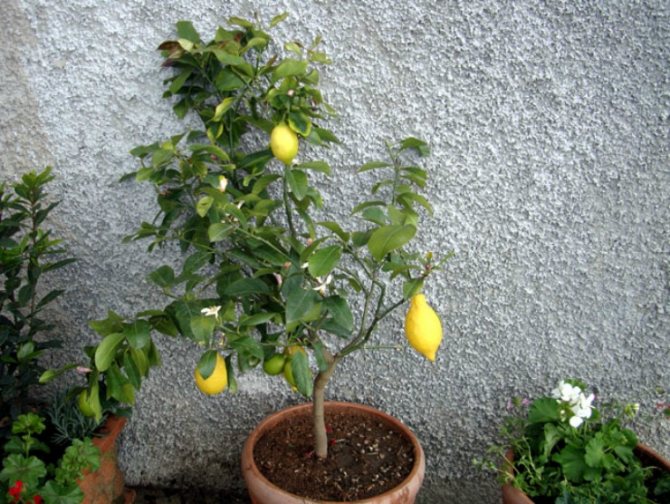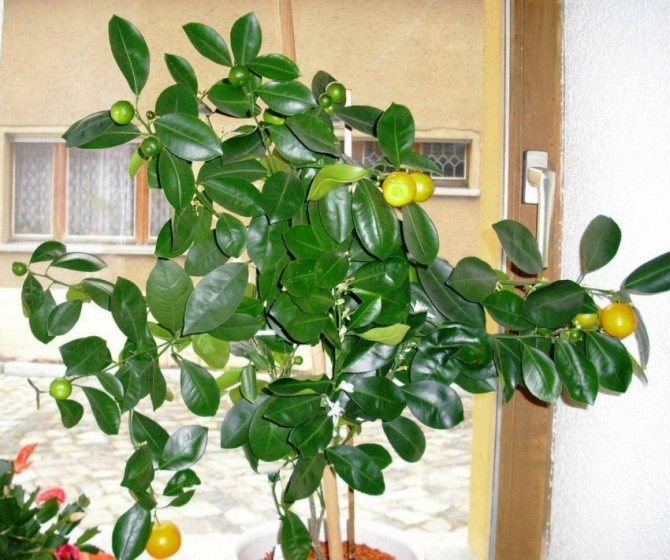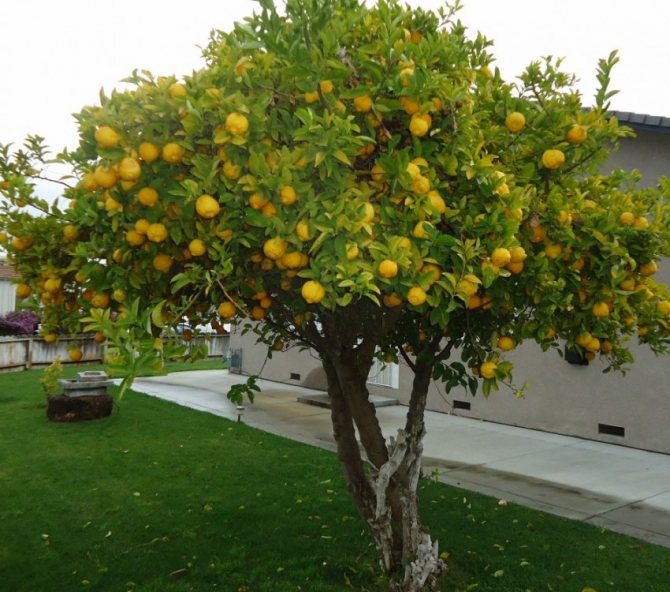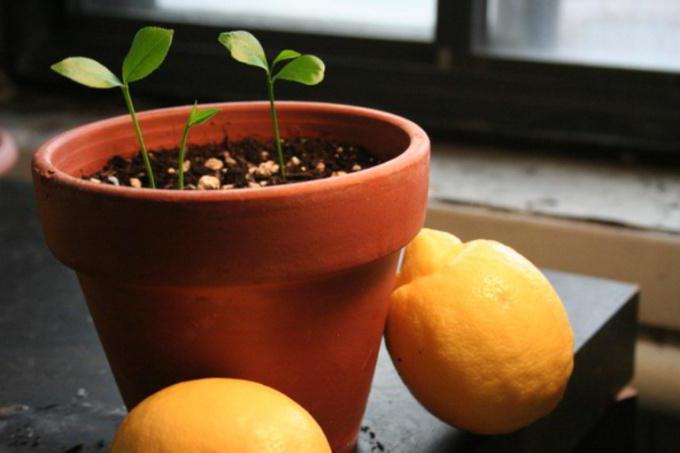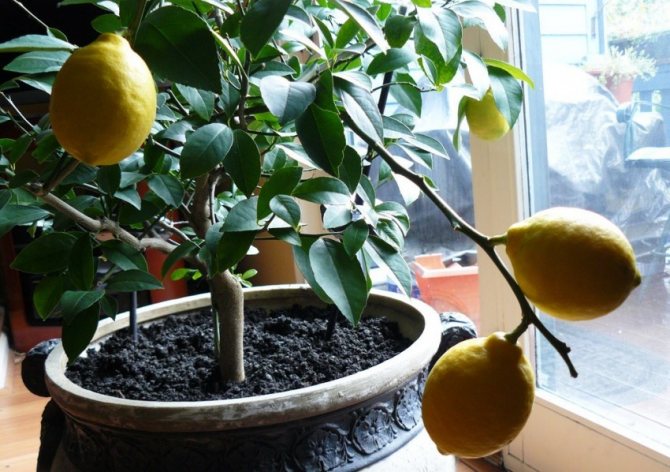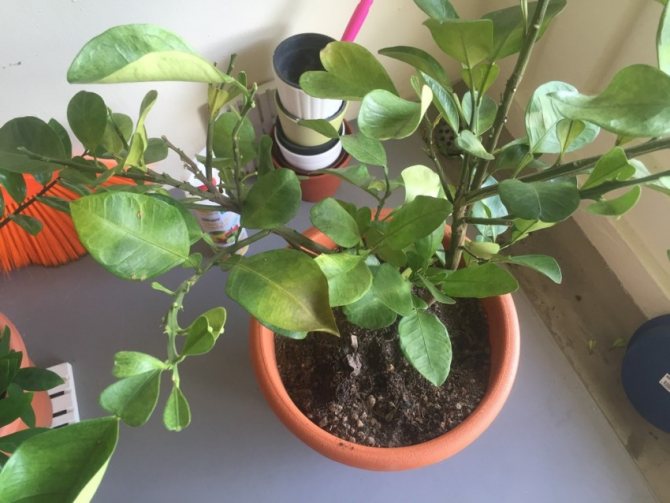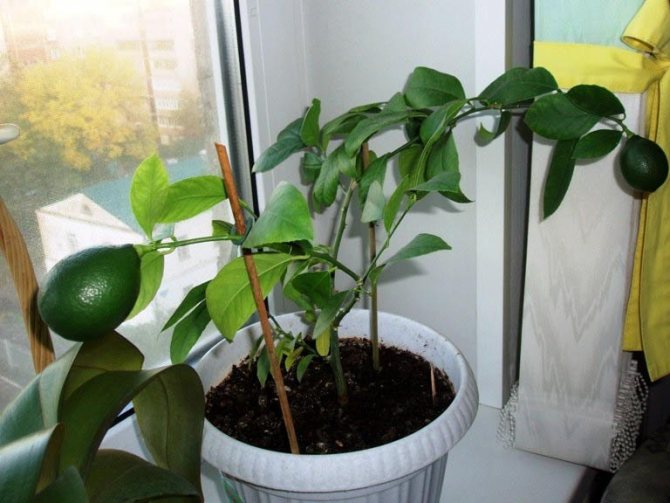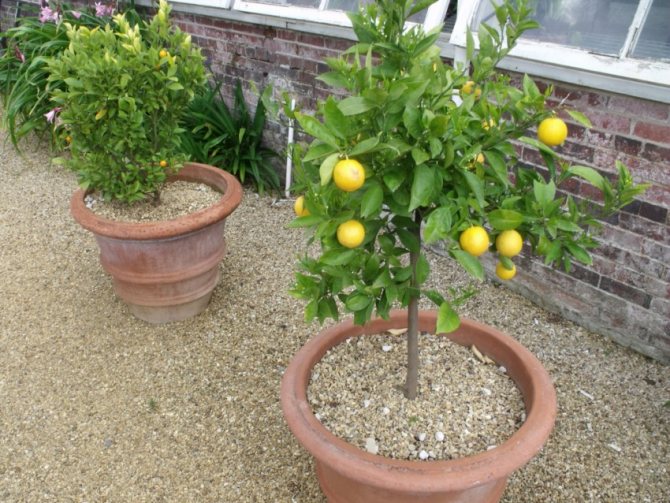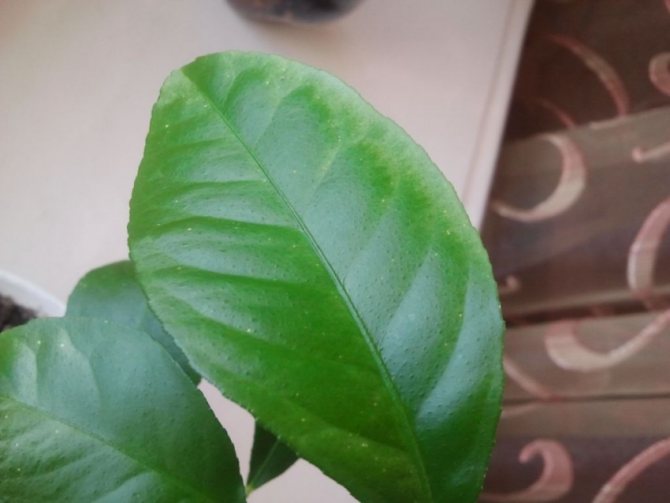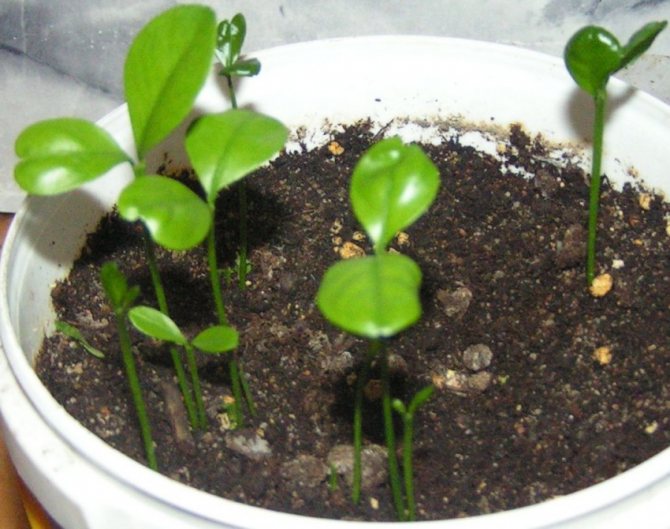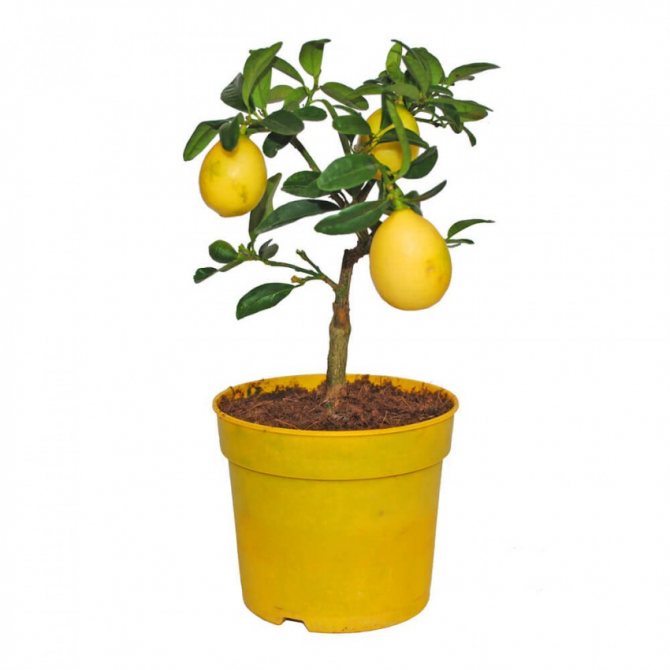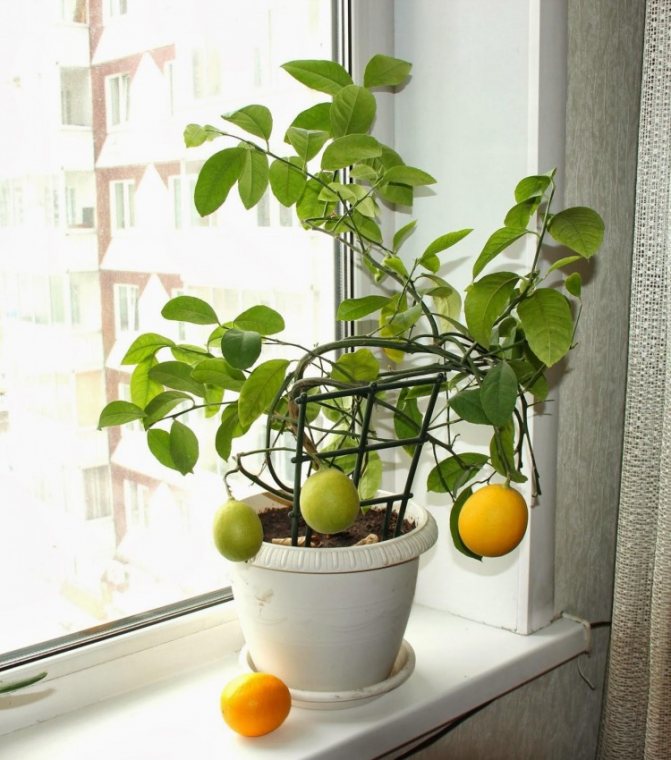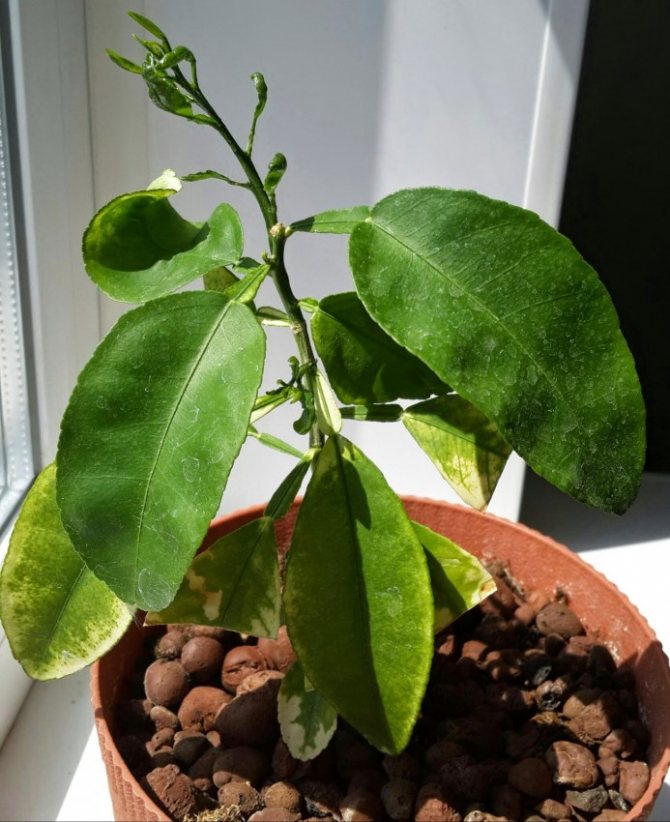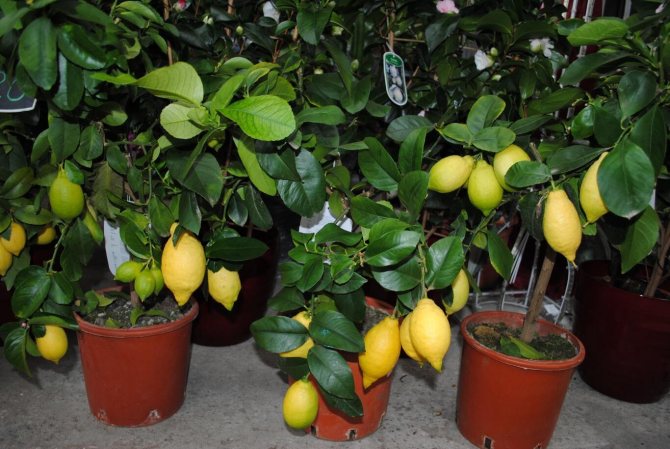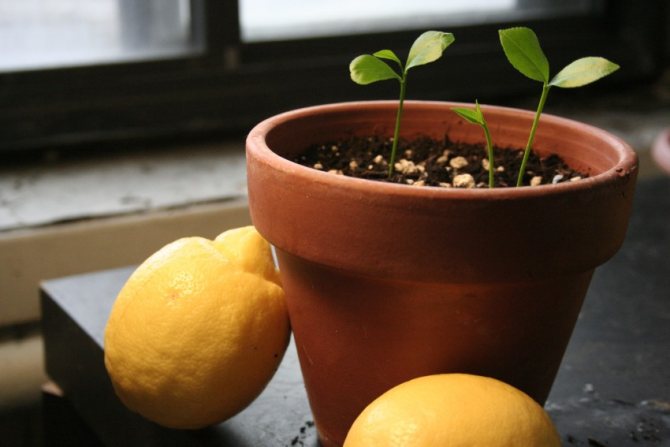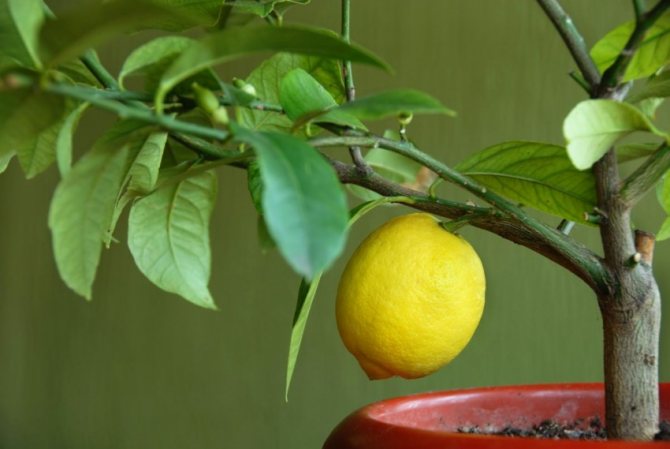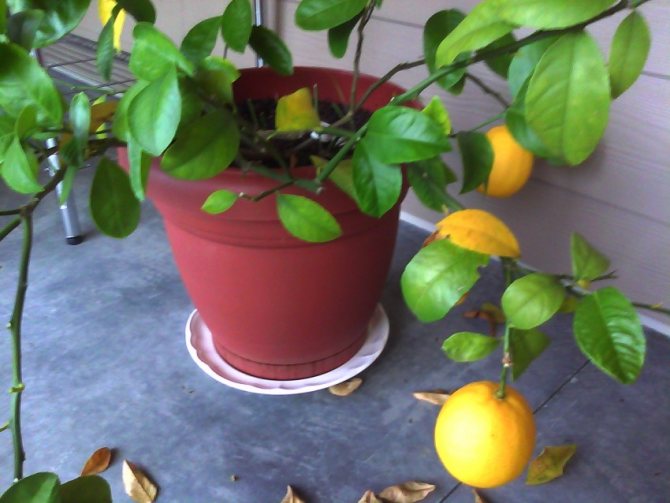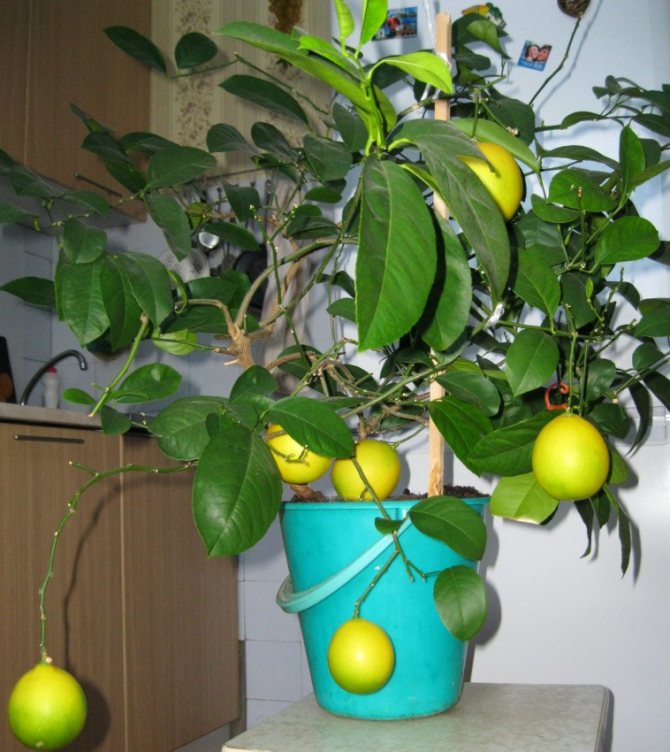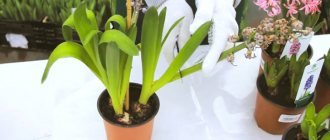An evergreen tree belonging to the genus Citrus (Citrus), as lemon (Citrus limon) is a member of the Rutacea family. Such a tree came to Mediterranean countries at the beginning of the 9th century, where it began to be grown as a cultivated plant. And it was brought from Southeast Asia. Under natural conditions, the original type of lemon is no longer possible to meet.
Lemon is grown as an ornamental and fruit plant. Since he loves warmth very much, in areas with harsh winters he is grown as a tub plant in indoor conditions. With the onset of the warm season, it is recommended to move it outside, and in the fall, bring it back into the room. Many different varieties of this plant are grown indoors, and they all bloom and bear fruit.
In addition to being very beautiful, the lemon tree is also incredibly healthy. So, the peel of the fruit itself contains a large amount of essential oils, and the pulp contains a large amount of various vitamins. The plant itself is also useful, which has the ability to maintain a favorable microclimate in the apartment. The fact is that it emits volatile substances (phytoncides), which in the best way affect the emotional state of people living in the house, and also help to strengthen their immune system.
In indoor conditions, this plant can reach a height of 150 centimeters. It has a branched erect stem, which becomes lignified over time. Young twigs are painted in a rich green color, but with age they are covered with a thin brownish bark. In order to form a beautiful crown, they resort to pruning the shoots.
Fragrant green leaves of this plant, the surface of which is glossy and shiny, have an oval-pointed shape. There are varieties that have small spines in the leaf axils.
Lemon blooms can occur both in warm and cold seasons. However, it blooms more abundantly in the spring. Fruits, flowers, as well as unopened buds may be present on the tree at the same time. Small creamy or snow-white flowers are collected in small brushes, but most often they are solitary. For the plant to bear fruit, the flowers must be pollinated. Fruit ripening is a rather long process and takes about 6 months.
Video: Lemon grafting
- Wrap the trunk in the area of the root collar with a rag.
- Insert a stick into this loop.
- Using one side of the stick against the stand, lift the tree up with the other.
- Fix this structure in a hanging position.
- Remove the old pot from the clod of the earth.
- Place a prepared pot with drainage and bottom soil under the tree.
- Dip a lemon in it and fill in the empty space.
- Free the trunk from the fabric and water the tree.
Make a rope loop over it.
Transfer at the place where the tree is grown. Before rooting, shade it with a fabric screen from direct sunlight.
If this method is beyond your power, partial soil replacement possible on a new nutrient soil. To do this, carefully remove the old soil from the tub by about half and fill it with new.
If you follow all the recommendations for transplanting, lemon tree will delight you with a bountiful harvest for more than one year .
And here are videos on how to transplant a lemon into another pot at different stages of growth.
Lemon is a citrus plant native to the tropics. Therefore, he will not grow in the garden. But many growers manage to enjoy the fruits grown in the apartment. How to grow a lemon from a seed at home? What to do to make the plant bear fruit?
Step-by-step instruction
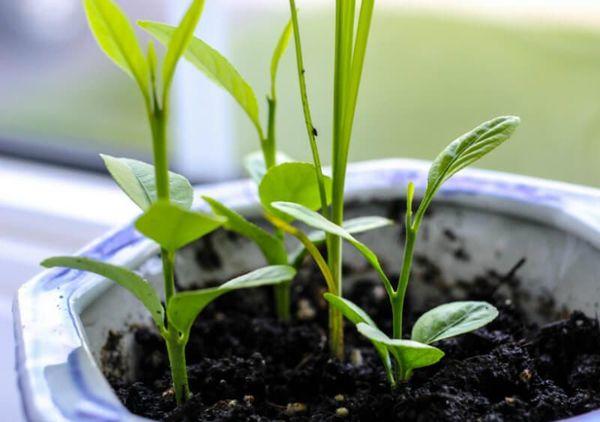
Transplanting a young indoor lemon is an important step in caring for such a plant. Therefore, a step-by-step instruction with key requirements and rules is what the florist needs to consider in detail, especially if a novice specialist takes up the work. What does the instruction for transplanting a room lemon include:
- first, provide drainage. A round-shaped crock is laid out at the bottom of the flowerpot and covered with a drainage mixture. Thus, moisture will not stagnate in it;
- then a small layer of soil is laid out in the pot;
- the plant is taken out of an old container. It is not recommended to completely cleanse the root system of an earthy coma, otherwise you may damage it, and the plant will begin to ache after transplantation. If desired, remove the top layer of the earth a little, but no more;
- if you notice dry or broken roots during the lemon transplant, they must be carefully cut off;
- place the plant in a new flowerpot and then dust the roots with earth;
- also try to compact the soil by gradually adding fresh layers of substrate;
- the root collar - the part of the plant that is located between the roots and the main stems, should not be covered with earth;
- when the key earthworks have been completed, be sure to water the plant, and very carefully;
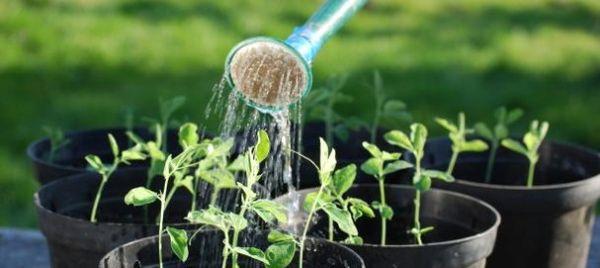

- the first time after transplanting, indoor lemon is not recommended to be exposed to the sun. Put a flowerpot with a plant in a shaded place, so it will much more easily bear the stressful situation associated with a transplant;
- after a few days, the indoor lemon can be placed in a well-lit area of your home. The main thing is to follow the basic rules of care and monitor the condition of the plant.
Can a transplanted tree be pruned? Many growers are interested in this issue. In fact, this procedure is optional. But if in the process of transplanting the plant you notice that the roots are dry or broken in places, it is recommended not only to remove them, but also to partially cut the plant from above. You will not bring any harm to the tree, quite the opposite: such a procedure will give a new impetus, favorably affecting the activity of the plant's development and the formation of young fruits on it.
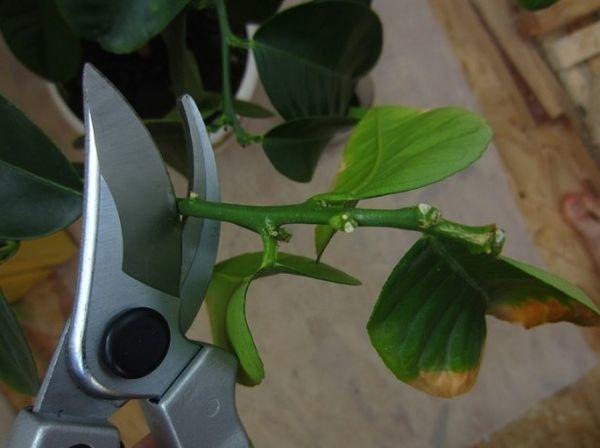

It doesn't matter where exactly you decide to grow indoor lemon or another plant similar to it: in a house or in an apartment. Here it is important to take the purchase of a pot and the choice of land seriously. Pay special attention to the step-by-step instructions for planting this tree - and soon it will delight you with its fast growth rates and many ovaries on the stems. In terms of care, indoor lemon is not particularly whimsical, so you should not have any problems with growing it.
Description of lemon
Lemon is an evergreen plant. Its young shoots are purple and brown over the years. Leaves are thick, leathery, oval. Each of them lives for about 3 years. On their surface are glands with essential oils.
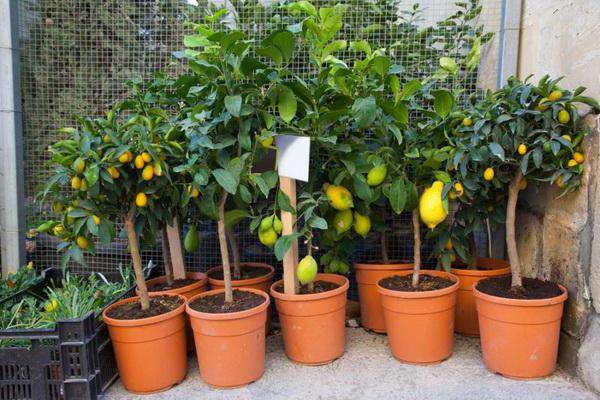

An adult plant forms flower buds. They develop slowly, each blooming over 5 weeks. After the bud opens, it blooms for 7 ... 9 weeks. The flowers have a strong, pleasant scent.
Gradually, a fruit is formed in the place of the flower. At first it is green, then gradually turns yellow. The fruits are covered with a thick, fragrant rind. Inside there is a yellow pulp, sour taste.The fruit is divided into several slices. There are seeds inside. The ripening process lasts 9 months and longer. At this time, the plant needs to create certain conditions. Lemon can be purchased or grown on your own.
Features of growing indoor lemon - this citrus plant in pots or tubs
In Russia, indoor citrus growing dates back almost three hundred years, because lemons were brought to the country even under Peter I. And now we have many amateurs growing this evergreen fruiting plant in a room or on a warmed loggia in pots or tubs.
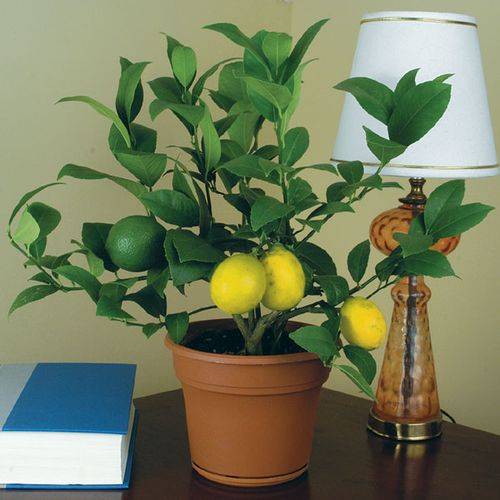

Perennial
lemon Tree
blooms quite profusely, but its flowers, as a rule, are not striking, since during this period they are usually completely covered with leaves. But you instantly feel that the air of the room is filled with a fabulous aroma. And even if you enter a room with a large set of indoor plants, then in this case the hard leathery shiny leaves of the lemon tree immediately attract attention, even if it has not yet started flowering. And even if this plant is "wild", i.e. not grafted, it is still unusually decorative, because it has beautiful emerald shiny leaves.
And it is no coincidence, apparently, in countries where citrus crops are grown, the bride is decorated with a large wreath of flowering lemon or orange branches for a wedding. By the way, if we see blooming apple orchards from afar - three to four hundred meters away, then the fragrance of a blooming grove of lemons, presumably, spreads for many kilometers.
Admittedly, growing lemons at home is not easy. Firstly, for this it is desirable to have a sufficiently spacious room with good lighting. Secondly, homemade lemon requires more attention than regular indoor flowers. But at the same time, it has many advantages over them: more hardy and durable; the whole plant smells good, releasing volatile essential oils that ozonize the surrounding air.
In indoor conditions, the oldest trees reach a height of 1.5 m, although in large rooms with huge light windows lemons grow up to 3 m or more.
Growing lemon fruits is a rather long and painstaking process, so you need to be patient in advance to wait until the lemon tree finally gains strength and blooms, and good-sized fruits form from the flowers.
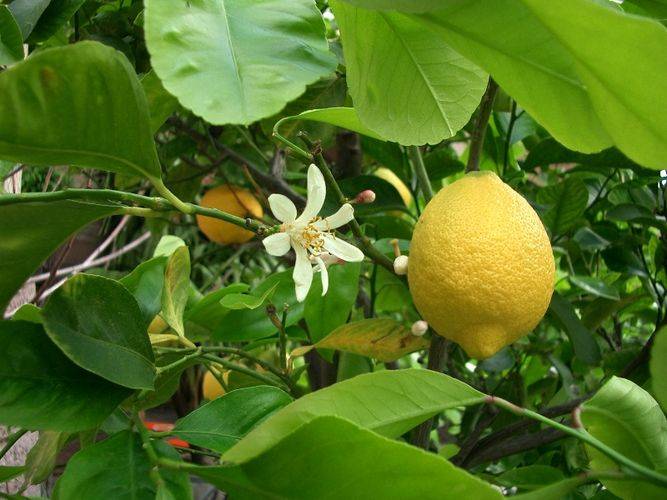

When growing homemade lemon
it is imperative to take into account its biological and varietal characteristics, to know the agrotechnical methods of cultivation, methods of its reproduction and measures to protect against numerous pests and diseases.
Hopefully, after reading this article, the number of people growing this magnificent plant at home will grow significantly. Having started a lemonarium at home, in a few years you will be able to treat relatives and friends with your own hands. lemon fruit
... After all, a normally formed five to seven-year-old lemon tree in a year can give a citrus lover from 15 to 50 fruits (depending on the variety).
Lemon is a small tree or shrub with strong, usually thorny branches. At the tops of its young shoots, the color is purple-violet. Leaves are oval, oblong, toothed; have many glands containing essential oil. Their change on the plant occurs gradually (as they age): the leaf lives for about 2-3 years. Lemon flowers are bisexual, arranged one at a time, in pairs or in small clusters, they are large (4-5 cm in diameter). The bud grows and develops for about five weeks, the flower blooms for at least 7-9 weeks. The period of growth and development of the fruit from setting (falling of the flower petals) to the beginning of ripening under indoor conditions during the spring flowering of the plant can last up to 230 days. In the summer period (optimal temperature and better lighting), this period is reduced to 180-200 days.If in the first year a young, recently grafted tree gives flowers, they should be cut off (better when they are still in buds) so that the plant does not waste its energy and preserves them for further normal development. With secondary flowering, the buds are no longer removed; more often than not, the tree itself decides how much it can "feed" the fruits, and how many "extra" flowers it needs to drop.
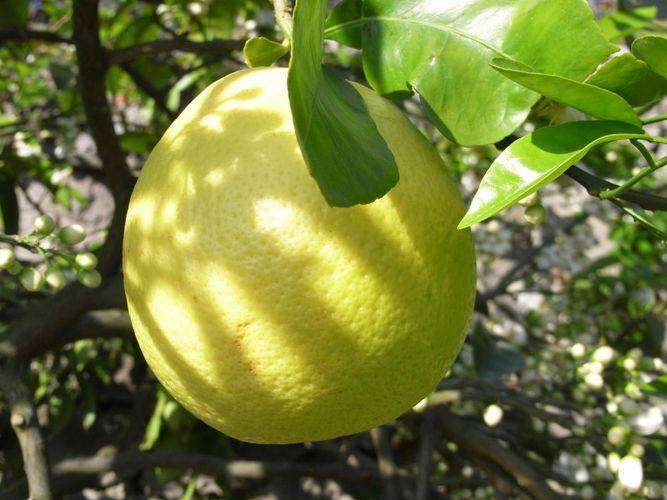

It is recommended to allow flowering and fruiting of a lemon if it has at least 20 full leaves.
Fruits on lemon are formed both with pollination of flowers and without pollination - parthenocarpically (in this case, seeds are not formed in the fruits). Lemon fruits are oval or egg-shaped. Their skin, when ripe, acquires a light yellow color and a strong lemon scent. Their flesh is usually greenish, divided into 9-14 slices, very juicy and sour. Seeds of irregular ovoid shape, white, covered with a parchment-like shell.
There is a close relationship between the number of fruits and the number of leaves on the tree. It has been established that for normal growth and development of each lemon fruit, the crown of a tree must have at least 9-10 mature (physiologically active) leaves.
When growing lemons, care for the plant should be such that leaves do not crumble from it. This happens most often during the winter. The condition of lemon trees can be judged by the degree of their foliage: the more healthy leaves on a tree, the better it grows and bears fruit. Without leaves, the plant will not be able to bear fruit: if, under unfavorable conditions, a lemon loses a lot of leaves, then the next year it will not form fruit. Therefore, the main task in winter is to preserve the leaf apparatus of the tree.
The full ripening of lemons is fully evidenced by their characteristic intensely golden peel, the color of which is given by carotenoids - sources of vitamin A. After full ripening, the fruits, as a rule, do not fall off, they continue to grow in the next year. But, increasing in size, they at the same time worsen their qualities (the peel thickens strongly, the pulp dries up and becomes flabby, the juice becomes less acidic).
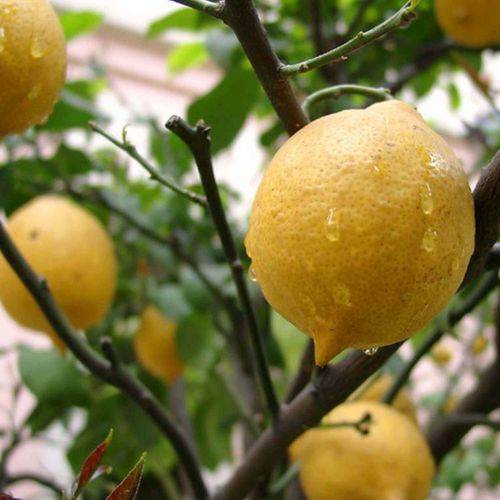

Under normal conditions, lemon grows, blooms and bears fruit throughout the year, therefore, the same plant can simultaneously have ripe fruits, young ovaries, flowers and buds. The period required for fruit ripening, and it begins from the moment they are set, largely depends on the period of flowering and setting. Fruit ripening during lemon flowering in the summer months occurs 1-2 months faster than in the spring. The time from setting to ripening of fruits can vary widely (7-14 months). Experienced amateur flower growers know how to regulate the timing of lemon flowering, skillfully applying various techniques, for example, temporary drying of the tree. Thus, a tree dried up (to the initial degree of leaf wilting) stops growth and flowering and enters a forced dormancy, in which craftsmen can keep it for some time. If after this they give abundant watering, then the lemon begins vigorous growth and profuse flowering.
When growing a lemon in a tub culture, it is very important to achieve its dwarfism, especially since the lemon tends to form very powerful, long (not branching only at the top) branches, so it will need to be cut regularly: without this, the shoots make the crown very voluminous. According to experts, it is advisable to prune all strong growths of the tree after 5-6 leaves, which makes the crown more compact, mechanically strong and productive. Systematic care is also required for the roots (it is carried out, as a rule, during transplantation), since they provide the vital activity of the plant. With abnormal development of the root system, lemon growth is inhibited, the color of the leaves changes, etc.
Life span indoor lemon
under favorable conditions it can be quite large. For example, I saw in the city of Pushkin a wonderful almost three-meter 30-year-old tree, it grows in a greenhouse and is, one might say, in its prime. Several hundred fruits hang on it at the same time.
As a rule, diseases and pests play a significant role in reducing the longevity of plants. If the owners treat their pet lemon caringly, like a family member, then under favorable conditions the tree's lifespan may well be 35-45 years.
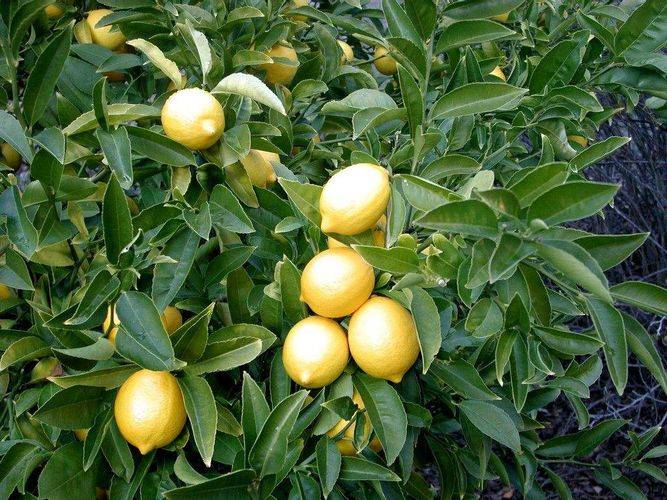

Being a southern plant, the lemon tree will definitely give a good harvest of fruits in indoor conditions, if it is provided with good care and all the conditions necessary for normal life. But I’ll notice right away: it has quite high requirements for heat, moisture and light. The optimum temperature for the growth of lemon leaves and shoots is about 17 ° C, and for the development of fruits 21 ... 22 ° C. Very high air temperatures are harmful to lemon, the plant reacts especially negatively if the temperature rises sharply while the relative humidity of the air is low. This happens in the spring months and early summer - it is caused by a sharp warming outside. A similar phenomenon can lead to the fall of flowers and ovaries, and a strong temperature drop in the autumn and winter months - and foliage.
Soil temperature should also be close to air temperature; especially harmful is a sharp lag of soil temperature from air temperature. This happens when a tub lemon, which has stood for a long time in the summer and even in the fall in the open air, is immediately brought into a warm living room when it gets cold. Sometimes he reacts to this by dropping foliage.
Lemon is sensitive to fluctuations in air humidity in the room. It reacts negatively to its deficiency, which is most dangerous (especially at high temperatures) during flowering and fruit setting. This causes shedding of flowers and ovaries. Some experts believe that the higher the air humidity, the longer the life of the lemon leaves.
Lemon is a plant of short daylight hours; he quite tolerates the lack of sunlight. With a long daylight hours, its growth is enhanced, and fruiting is delayed. The most favorable for indoor growing are windows on the south and east sides. On the south side, it receives a lot of light in summer, but it should be shaded with a gauze curtain from direct sunlight (this is especially important during the midday hours). Some experts consider the eastern side to be universal: its morning sun rays, although bright, are not so scorching, and such lighting is quite enough for plants.
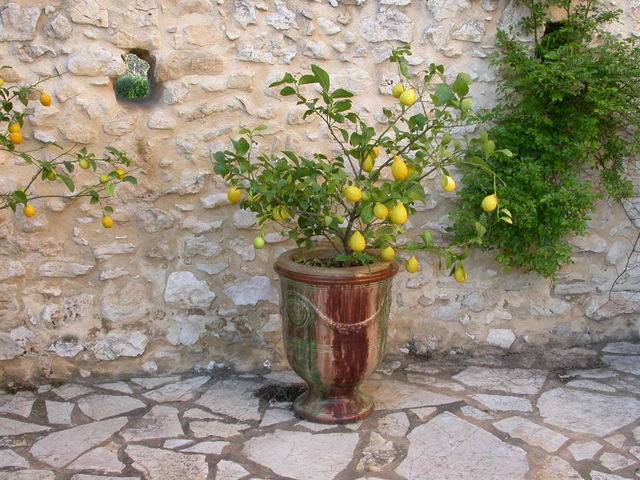

To prevent a one-sided tree from growing, it is recommended to turn the box with the plant at a small angle every half month. Although due to this procedure, the growth of shoots and leaves is somewhat inhibited (lemon is very sensitive to changes in lighting and rearrangement from place to place), but the plant is formed of the correct shape. Other experts advise making turns by about 10 ° every 10 days: then it will take a year for the plant to rotate completely. It should also be borne in mind that lemon is sensitive to a sudden change in lighting: as its intensity decreases, the size of new leaves increases.
During the winter period, the lemon will not be disturbed by daylight (5-6 hours) with a fluorescent lamp (or a 100-150 W incandescent lamp), which is placed at a height of 60-80 cm above the plant.
The period from October to March is the most difficult for plants, due to non-compliance with the conditions of detention during this period, they often die. In winter, with battery heating, the air in the room is dry, so it is better to move the plants away from the heating devices (sometimes the batteries are covered with damp cloth); you can spray the leaf surface with a spray bottle.However, it must be remembered that excessive spraying of the leaf surface, especially the Meyer variety, can contribute to the development of fungal diseases. It also does not hurt to keep water on the surface of the soil in a pot (or nearby) in a wide bowl for evaporation. In summer, it is advisable to rinse the leaves under the shower at least once every 1-2 weeks or gently wipe them with a damp cloth so that they are clean and breathe deeply.
The lemon tree has been grown in the same soil for several years, therefore, a substrate correctly selected for it, as well as fertilizing with fertilizer mixtures, is of great importance for its normal life. We'll talk about this later.
Alexander Lazarev, Candidate of Biological Sciences, Senior Researcher, All-Russian Research Institute of Plant Protection, Pushkin
Growing a lemon tree
How to grow a lemon from a seed at home? You can use the seeds obtained from the purchased fruit for this. It is only necessary that it is ripe, the seeds are large and hard.
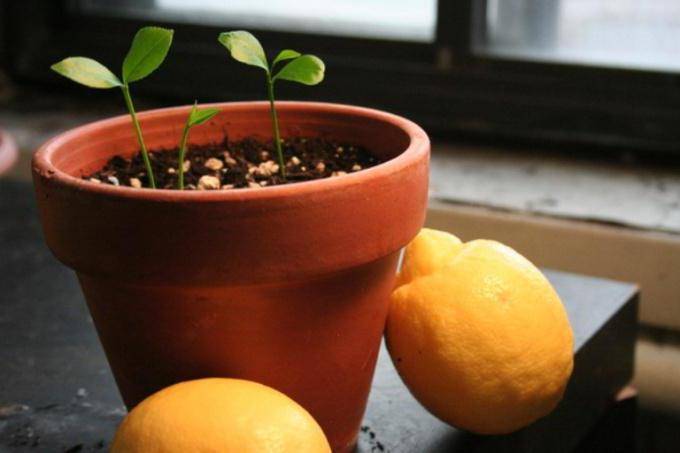

It is better to graft the plant after a while. After all, lemons grown from seeds enter fruiting no earlier than 6 years later, and grafted lemons - the very next year after vaccination.
You can use cuttings 10 cm long and 4 mm thick. They should have at least 2 leaves and 3 buds. The stalk is treated with "Kornevin9raquo;" They are kept in water for a couple of days, then planted in pots. The land for them consists of soil for flowers, sand and humus. The seedlings are sprayed every day. Do not flood the soil. At temperatures up to 25 degrees, the roots will appear in a month and a half.
A young lemon is planted in a pot. Transplanting and home care of plants obtained from cuttings is the same as for those grown from seeds.
Lemon needs loose soil, it should allow air and moisture to pass through well. Take soil for flowers from the store and peat.
Dishes with large drainage holes are prepared, drainage is laid on the bottom. Fill in a layer of prepared soil mixture. Seeds are sown to a depth of 2 cm. They germinate in a couple of weeks.
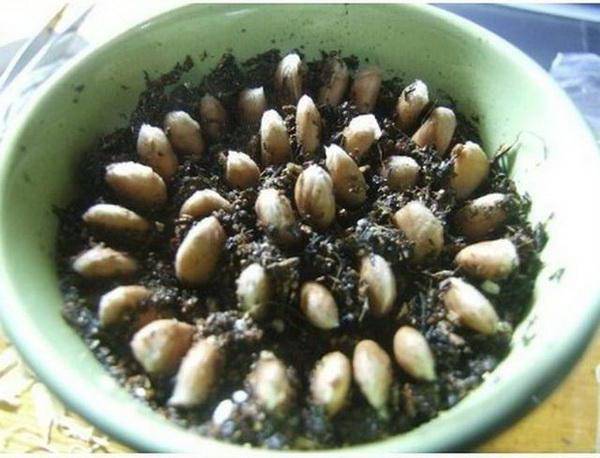

Lemon - home cultivation
As you know, it is not easy to grow a whimsical lemon in a room environment. This requires the optimal creation of growing conditions close to tropical, as well as timely, regular care... Of great importance in the cultivation of citrus is its variety.
Under indoor conditions, the success of growing a tree is guaranteed in a bright, ventilated room and if there is regular feeding.
Today, it has become very fashionable to grow citrus fruits at home, including lemons. In specialized stores appeared a great variety of varieties both the lemons themselves and their hybrids.
How to deal with such an abundance, how to choose a variety that suits your climatic and indoor conditions?
Types and varieties of lemon for home cultivation
The following lemon varieties are ideal for indoor cultivation:
- Pavlovsky. An old variety popular with gardeners. It begins to bloom in the third year after planting. Fruits with a thin skin, weighing 200-400 grams, are very tasty. A tree can give from 6 to 15 lemons per year.
- Lunario. Most widespread in Europe. It blooms for 2-3 years and bears 8 to 16 fruits weighing 130-180 grams. The taste of lemons is average. The variety is very unpretentious and does not require special care.
- Ponderosa. The tree is small (up to one meter), blooms for 1-2 years. The fruits are delicious, weighing up to 300 grams. The only negative is the low yield (3-5 per year). The variety is unpretentious.
- Lisbon. The variety is resistant to heat, unpretentious in care, has thorns on the branches. Fruits 180-200 gr with excellent taste. Fruiting for 3 years after planting, the yield is from 6 to 16 lemons. The height of the plant can be reduced by properly shaping the crown.
- Meyer.Due to its small size (0.5-1 m), this variety has won the greatest popularity among fans of ornamental plants. Blooms for 1-2 years. Fruits 150-190 gr, average taste. The tree produces 6 to 15 lemons per year.
Also suitable for growing at home are varieties such as Novogruzinsky, Villafranca, Maikop (have the highest yields), Genoa and Kursk, variegated Eureka (white streaks are visible on the leaves).
Seedling care
The soil should be watered regularly with warm, settled water. When the seedlings have a couple of leaves, they are planted in a separate bowl. You can immediately plant one or two seeds in a pot.
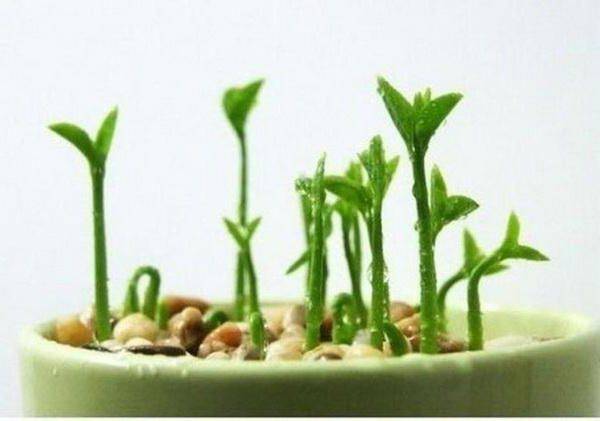

The transplanted plants are covered with jars. This will help to create the optimal temperature and moisture level. Every day they are removed for half an hour so that they adapt and ventilate.
Pot for growing lemon.
From Sofia from Yekaterinburg, Russia. July 20, 2009
I really liked your site, it is so colorful and detailed, but, alas, I did not find information about transplanting lemons, or rather, what diameter should be a pot for a plant with a crown circumference of about 1 meter? From my grandmother, I inherited the Ponderosa lemon, he is already 30 years old, or even more. I don't know at all how developed the root system of indoor lemons is. In the spring I would like to transplant my treasure into another pot and do everything scientifically without destroying the plant. What can you recommend to me, does the material of the pot matter (plastic, ceramics ...) and which is better for a lemon - a planter or a pot with a tray? What is the diameter of the plant pot? ... I am sending a photo of my pet and the harvested crop. All the best and good luck.
Answer
I couldn't write the exact dimensions. There are many nuances that the size depends on. First of all, it depends on the wishes of the hostess. A 20-year-old Ponderosa lemon can be a meter in diameter and 1.8m in height, and grow in a 100L pot. Your plant has a small pot, 12 liters, and the tree is accordingly small.


It seems to me that you have 3 trees in one pot (perhaps I am mistaken). You can seat them. But, now IT IS VERY DIFFICULT. The roots are likely to be damaged. I would plant and put in a greenhouse for 2 months. The big one would be left in the same pot. During transplanting, the roots would be treated with a rooting stimulant. For the inexperienced. If you don't know how to seat, do a transshipment, just the size of the pot needs to be increased by 4-6 centimeters in diameter. Leave almost all of the old soil and top up with fresh. It is advisable to treat the tree with an anti-stress drug a week before transplanting. Don't be greedy, these drugs are not very expensive. After transplanting, within a month, it is advisable to spray with water.
Sofia
Does the pot material matter?
Answer
It has. You have a tree on the windowsill - it means plastic. I specify - FIRMED plastic, brown! Less commonly, they are black, gray and green. These are fine too, but brown is better. Make sure to drain well.
It seems to me that you have a lemon growing in a flowerpot. Once bought, let it be. But I don't like that kind. From below you need to drill 5-10 holes with a diameter of 10 mm for water drainage. The planter can be made of plastic that affects the plants - this is not good.
Sofia
A pot in a planter or a pot on a pallet is better?
Temperature
Indoor temperature depends on the phase of plant development. During the period when it does not bloom, 17 degrees is enough. The optimum temperature for the formation and development of lemon buds is considered to be 14 ... 18 degrees. If it rises higher, the flowers and already formed ovaries fall off. When the fruits grow up and begin to ripen, the temperature is raised to 22 degrees.
In summer, lemon can be grown outdoors or on the balcony, but during this time there should be no temperature changes. Therefore, it is advisable to wrap a pot with a plant at night.
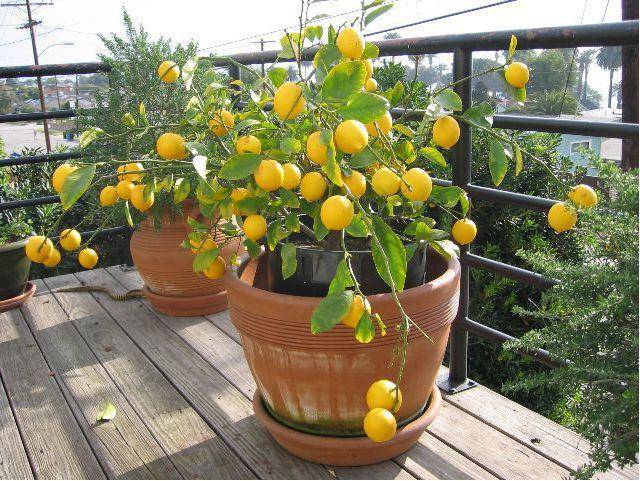

In winter, at rest, lemon is placed indoors at a temperature of about 13 degrees. There should be no radiators nearby.
During fruiting (May-September), the lemon is watered every day with filtered or settled water at room temperature. Then, the intervals between watering are increased, bringing their number to two per week. Water it abundantly, but only when the ground dries up. If you overmoisten it in autumn or winter, the roots can rot. To prevent this from happening, you need to completely change the soil.
Lemon leaves need additional moisture. This is especially important in winter if the room is heated. Spray the leaves with warm boiled water.
Lemon that hibernates in a cool room is not sprayed. Excessive moisture can lead to the development of fungal diseases.
Optimal timing for transplant
When is it correct to transplant a lemon so that it takes root well and does not get sick? Experienced florists recommend doing this before the plant leaves a state of dormancy and sap flow begins. The ideal time is late February - early March, but the procedure can be carried out in the middle of summer. In the fall, transplanting is carried out only if absolutely necessary, if there is a threat of death of the tree.
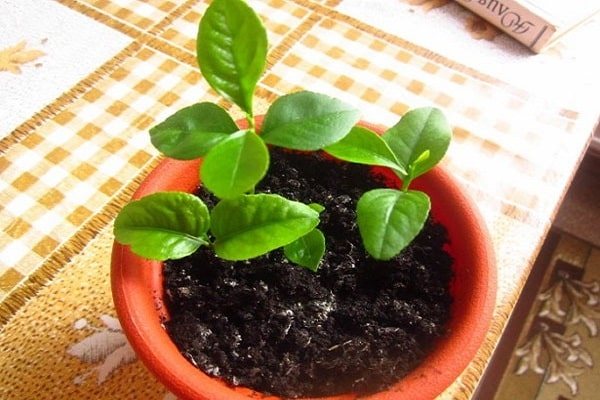

Transplanting a lemon into a new pot
After the seedlings grow up to 15 cm, they are transplanted into a new pot, the diameter of which will be 5 cm larger than the previous one. In such a dish, the roots will grow rapidly, filling the space of the pot. If you transplant homemade lemon directly into a large pot, the soil in it will sour from moisture.
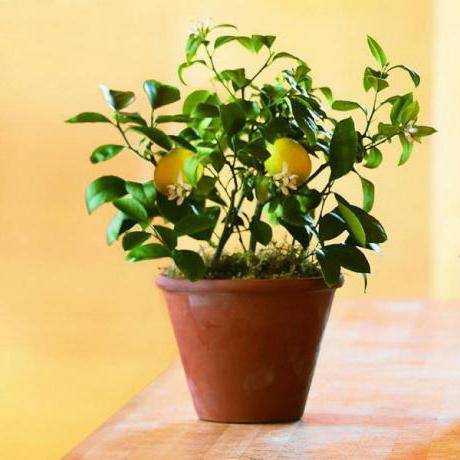

It is best to plant the seeds immediately in separate pots. This will reduce the number of transplants, improve the condition of the lemon. This will keep the root system intact.
Transplanting a lemon into a new pot is carried out by the transfer method. The new pot should also have good drainage and holes to drain moisture away. Its diameter should be 2-3 cm larger than the previous one. The soil can be taken the same as when sowing seeds. You can get a store-bought mixture or a mixture of garden soil and humus. Transplanting a lemon into a new pot is carried out so that the root collar remains at the soil level.
In what cases a transplant is required
Transplanting indoor plants is done for one of several possible reasons. Citrus can get cramped in the old container, they can suddenly get sick, or after buying a tree in a store, you need to put it in a permanent pot.
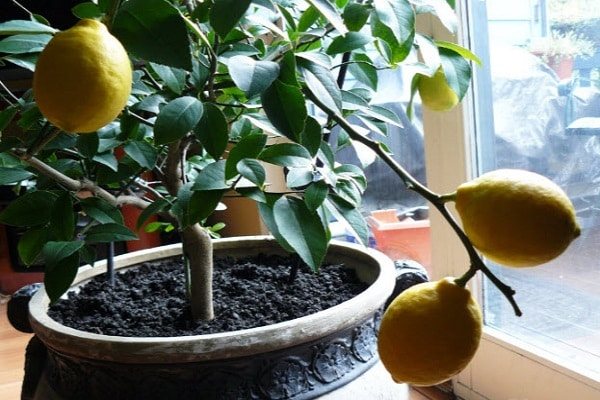

Planned transplant
Planned transplantation of a lemon tree is carried out as the root system of the pot fills it. If they are starting to peek out of the drainage hole, then it's time to relocate the plant. It is preferable to plan the work in February or early March, while the lemon has not started to grow. However, if necessary, you can make a transplant in the middle of summer.
Before moving the seedling to another pot, a layer of drainage is placed on the bottom of the vessel, on top of which a small amount of sand is poured. After that, you can pour in a nutritious soil mixture, set a lemon along with an earthen lump. The root collar of the plant should be slightly below the edge of the pot. Next, they fill up the earth so that there is little room for watering to the edge. The soil is tamped and watered abundantly.
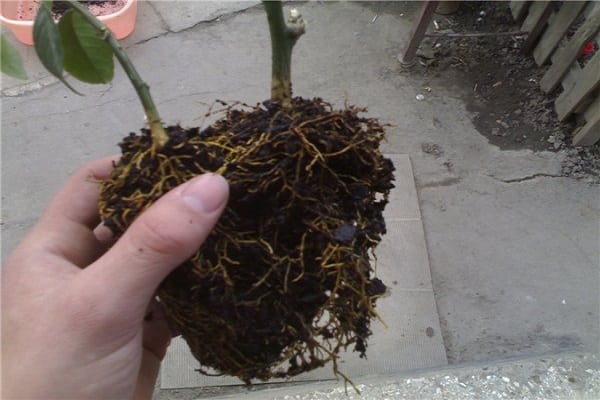

After buying a new tree
After buying a lemon, he will also need a transplant. As a rule, flowers are sold in so-called temporary pots, which are not suitable for long-term growing of plants. The purchased seedling must be kept separate from other indoor flowers for the first time in order to avoid spider mite infestation.
Before transplanting, a new container, drainage and nutrient mixture must be prepared in advance.Pour a drainage layer on the bottom of the pot, then a layer of soil, place a lemon in the center along with a lump of earth and add the required amount of soil so that there is room for watering to the edge of the pot. To make it easier for the plant to take root, you can cover it with polyethylene for a while, making a kind of greenhouse.
See also
How to properly pinch a tangerine tree at homeRead
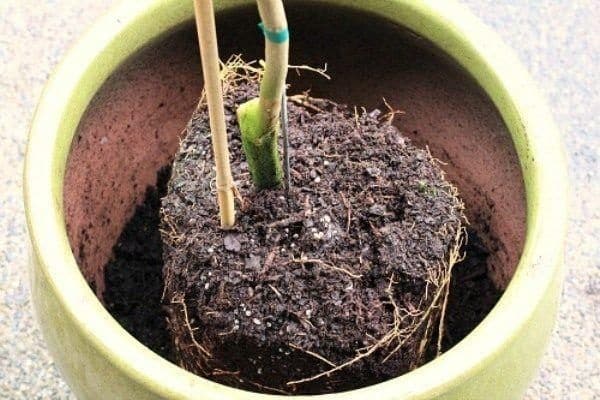

If the plant is sick and does not grow
When the first signs of lemon disease or its growth stop are detected, it is necessary to examine the tree and take measures for its rehabilitation. An unscheduled transplant is not excluded. The plant should be removed from the pot and the root system should be examined. If an unpleasant smell is heard, and signs of decay are visible, then the diseased roots are cut off with a sharp knife, the cut points are treated with a solution of potassium permanganate, and sprinkled with wood ash. Further transplantation technology is no different from the planned one.
Fertilization
A good harvest of lemons cannot be obtained without constant feeding. The easiest way is to apply a complex fertilizer for indoor lemons. He responds well to the introduction of ash diluted with water. To do this, they are crushed, kept in water for 2 days. You can use an infusion of manure, diluting it in a ratio of 1:10.
For young plants, one feeding is enough for a month and a half.
In spring and summer, an adult plant is fed 2 times a month. In the fall, a lemon, located in a warm room, is watered every six weeks. The plant does not need feeding in a cool room.
Do not fertilize dry soil. Therefore, before feeding, the plant is watered with clean water.
With the help of fertilizers, you can achieve an acceleration of fruiting. To do this, reduce the amount of nitrogen fertilizers, increase the amount of phosphorus.
When it is necessary?
The root system of a lemon is limited by the size of the container in which it is planted. In order for it to grow and bear fruit normally, a regular transplant is necessary.
The frequency depends on the age of the tree:
- 1-2 years old - it is not recommended to transplant;
- 2-3 summer plants - twice a year;
- 3-4 year olds - once a year;
- 4-7 year olds - every two years;
- Over 10 years old - transplant every 9-10 years.
In addition to the planned ones, it may be necessary transplants according to the state of homemade lemon... They are carried out in the following cases:
- The size of the pot was chosen incorrectly and the soil began to sour. The plant must be transplanted into new soil regardless of the season, otherwise it will die.
- Buying a plant in a small pot. This is especially necessary when the roots stick out of the drainage hole, which indicates a lack of space for their growth. If you do not transplant such a specimen into a spacious container, the lemon will stop growing and die.
- Roots are visible around the trunk. This means that the root system has mastered the space of the pot and there is not enough space for further growth.
- Reducing the number of fruits formed. The plant looks healthy but flowers are not set. So the soil is depleted and needs to be replaced.
- A putrid smell is felt from the pot, fleas have appeared - evidence of acidification, rotting of the roots.
Assess the clod before replanting. If it is not completely entangled in roots, give up the transshipment - the plant has not yet fully mastered the old soil, the roots will become bare and suffer.
Pruning indoor lemons
Lemon crown needs to be shaped regularly. This is done in two ways, depending on the purpose of the plant. If it is grown only as ornamental, it is pruned to produce a small bush.


For active fruiting, you need to get a tree with a sufficient number of shoots and leaves. Usually the fruits are formed on the branches of the fourth order. They need to be formed as quickly as possible.
The main method of formation is by pinching young shoots. The first time it is done when the seedling reaches 20 cm.Then pinch at a distance of 15 cm from the previous one, making sure that there are at least 4 kidneys in this area. The main shoots are subsequently obtained from them.
The branches of each successive order should be shorter than the previous ones by 5 cm. This will allow the formation of a compact crown.
In the future, the shoots that are broken and growing inward are cut off.
Which land to choose for homemade lemon?
The choice of land for transplanting a plant must be approached with special care. Its further development essentially depends on this. 1055; ochvo-mixture, according to its main characteristics, should be similar to the one in which the plant lives in its natural environment.
The soil must be nutritious at the same time, it must allow air to the roots, be moderately loose and have the acidity necessary for the plant, the so-called (pH). In garden centers, ready-made soil for plants is widely presented. But you should not always believe only the name on the bag, be sure to read the composition. Under the guise of land, you can simply sell peat enriched with microelements.
For citrus plants, ready-made soil is also sold, you can use it if it has a good composition. Citrus soil should be a mixture of turf, humus, leafy earth, and sand. If only peat is written on the bag with soil for lemons, then it must be mixed with river or lake sand and with leafy soil taken, for example, in a forest or park from under a birch.
Diseases and pests of lemon
For many lovers, the leaves on the lemon turn yellow and fall off. This can be caused by:
- dry air;
- inadequate nutrition;
- high temperature in the room in winter;
- when infected with a spider mite (you need to fight it with Fitoverm9raquo;, Akarin9raquo;).
Often novice gardeners complain that the indoor lemon has shed its leaves. What to do in this case? You need to see which of the points of care is not being performed, and change the mode. Perhaps this is a consequence of the transplant. If done incorrectly, the root system can be damaged, leading to leaf fall. Therefore, a lemon is transplanted into a new pot in the first years of life every 2-3 years.
Leaves and stems, especially young ones, can damage aphids, scale insects, whiteflies, mealybugs. To get rid of them without the use of chemicals that are undesirable in the apartment, use an infusion of garlic. To prepare it, the garlic is chopped, infused in water for 5 days. Filter, pour 6 g of infusion into 1 liter of water, spray the plant. But if the pests have spread over a large area, such a remedy is unlikely to help.
Surprisingly: Husbands want their wives to do these 17 things more often. If you want your relationship to be happier, you should do the things on this simple list more often.
Unforgivable mistakes in films that you probably never noticed There are probably very few people who would not like to watch films. However, even in the best cinema there are mistakes that the viewer can notice.
How to look younger: the best haircuts for those over 30, 40, 50, 60 Girls in their 20s do not worry about the shape and length of their hairstyles. It seems that youth is created for experiments on appearance and daring curls. However, already the last.
Why do you need a tiny pocket on jeans? Everyone knows that there is a tiny pocket on jeans, but few have thought about why it might be needed. It is interesting that originally it was a place for the Chr.
What is it like being a virgin at 30? What is, interestingly, women who did not have sex until almost middle age.
13 Signs You Have The Best Husband Husbands are truly great people. What a pity that good spouses don't grow on trees. If your significant other does these 13 things, then you can.
Pick up utensils (pot, tub) corresponding to the age of the tree. Can be planted lemon in clay, plastic or wooden containers.The main condition is the presence of a drainage hole at the bottom of the pot. For 1-2 year old seedlings, the diameter of the pot in the upper part should be at least 20-30 cm.For 3-4 year olds - at least 30 cm.For 5-6 year olds - 30-35 cm.For plants that are more than 7 years old - not less than 45 cm. Poor growth, yellowing of leaves and souring of the soil in the pot can also serve as a signal for replanting.
Prepare a new potting mix. Composition: 1 part of river clean sand, 1 part of leafy sod land and 1 part of rotted manure or compost. In specialty stores, you can buy ready-made potting soil for citrus crops.
At the bottom of the prepared container, place the crock with the convex side up and cover the drainage mixture with a layer of at least 3 cm. This will prevent the water from stagnating in the pot. Place a few handfuls of soil on top of the drain.
Gently remove the cloddy plant from the old pot. It is impossible to destroy the earthen lump during transplantation, otherwise the plant will be sick for a long time or even die. You can only carefully remove the top layer of earth above the roots.
Examine the roots of the tree. Carefully cut off all broken, shriveled roots with a sharp knife. Do not jerk or try to unravel them. When pruning the roots, it is worth shortening the shoots of the plant a little.
Install lemon in a new pot on a prepared layer of earth. Holding the tree by the trunk with one hand, pour the earthen mixture into the free space between the pot and the old earthen lump. Compact the ground well. Make sure that the root collar (the place where the stem passes into the roots) is not covered with earth.
Water the transplanted plant well and shade it out of direct sunlight for a few days. Place the pot so that lemon took the previous position in relation to lighting.
How to properly transplant a lemon (lemon tree) into a new pot, what container to buy, what potting mix and fertilizers to use, you can learn from our step-by-step instructions for transplanting such a wonderful citrus tree like lemon.
Transplanting a lemon into a new pot
When does a lemon need a transplant?
A lemon (lemon tree) transplant should be done every year. A young tree requires replanting much more often: once every six months. A mature lemon tree needs to be transplanted once every three to four years, and the older it becomes, the more the transplanting process will stretch in terms of time. Repotting the lemon should be done in the spring, when the tree is entering its main growth phase, as the adaptation process takes place much faster, weeks in other seasons. It is also recommended not to water it so that the adaptation is faster.
How to determine if a lemon needs a transplant if you forgot to mark the dates? The surest way how to determine if a lemon needs a transplant - see if roots are sprouting from the drainage holes of the pot. From this, accordingly, the next point emerges - the choice of a pot.
Choosing a new lemon pot
A pot for a lemon tree should be chosen a couple of centimeters in volume more than the previous pot. In addition, as mentioned above, the new lemon transplant pot must have special drainage holes in the bottom.
It is better to opt for a pot that is wider than deep, since lemon roots tend to grow in breadth.
Soil substrate for lemon tree
At the bottom of the pot for transplanting a lemon tree, a drainage layer 2 centimeters thick must be laid out. On top of it, you need to place 2-2.5 centimeters of pre-steamed river sand. Next, you need to place the potting mixture in the pot. It will take so much so that you can submerge the roots of the lemon completely, sprinkling a little with the rest of the soil substrate to the root collar. After transplanting, water the lemon tree with water to nourish the root system.
It is imperative to make sure that the root ball of the lemon is installed vertically and the plant itself does not tilt in any direction, otherwise there will be a pathology in the development of the tree. In addition, you need to gradually add soil to the pot, while maintaining a static vertical position.
How to care for a lemon after a transplant?
Caring for a lemon tree after transplanting consists in regular watering, feeding and observing the basic conditions for the location of the tree. Watering is necessary constantly and abundantly, but letting the top layer of the potting mix dry out so that the roots do not start to rot. Excess water that will collect in the pan must be drained!
In the future, the frequency of repetitions of watering should be reduced to several times a week. This can be done after full adaptation of the lemon tree after transplanting - after two weeks. Also, do not take the tree to the extreme - the complete drying of the soil substrate, which will collect in dried lumps, otherwise it will be extremely difficult to restore the vitality of such a tree.
Please rate the material you have read :)
(No ratings yet. Be the first!) Loading.
Selection of capacity
Before replanting a citrus tree, you need to decide on the choice of a new pot. It should be larger in diameter than the previous one. It is also necessary to pay attention to the presence of drainage holes in it. Excess moisture is harmful to the plant. The roots will start to rot and the plant will get sick.
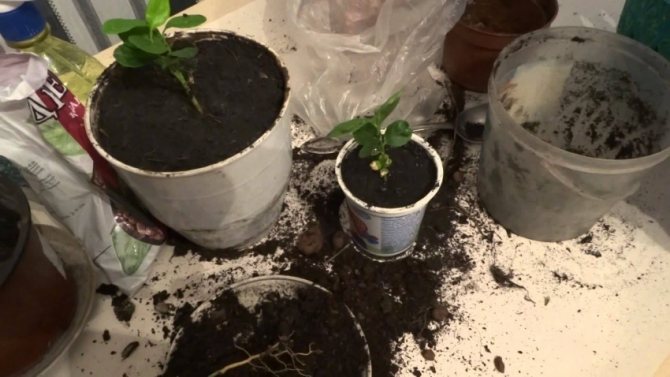

When using a clear or light-colored pot, wrap it in dark material. Otherwise, the soil will be covered with moss and the plant will get sick.
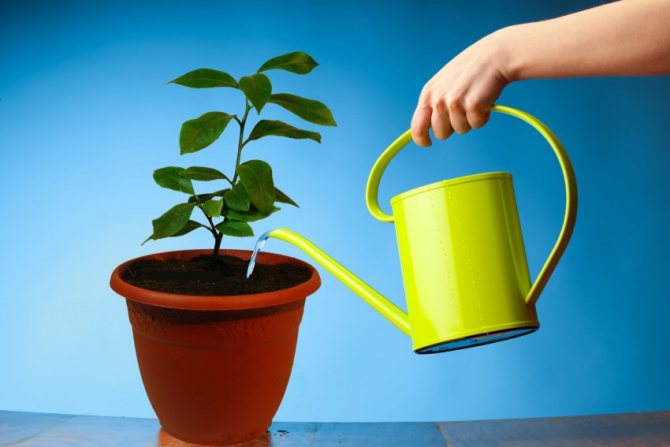

If your choice is a ceramic container, then before replanting a citrus tree, it should be placed in water for several hours. Otherwise, when watering, the ceramic material will absorb moisture.
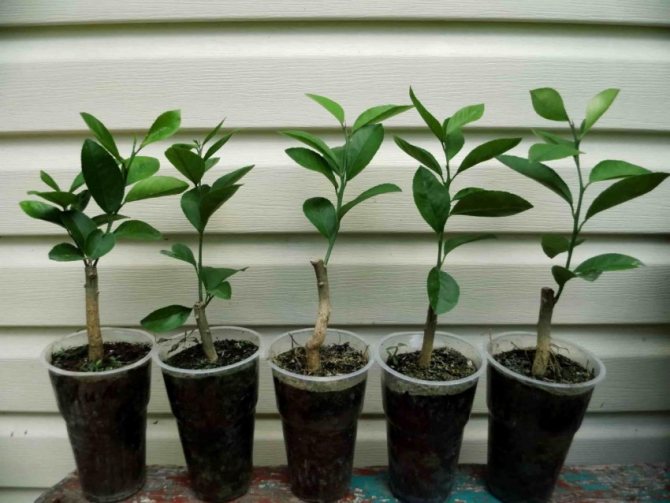

A dark plastic pot is an ideal option for replanting a lemon, since it will not absorb water from the soil, and the tree will receive the required amount of nutrients. But when using a plastic transplant pot, put five centimeters of drainage on the bottom.
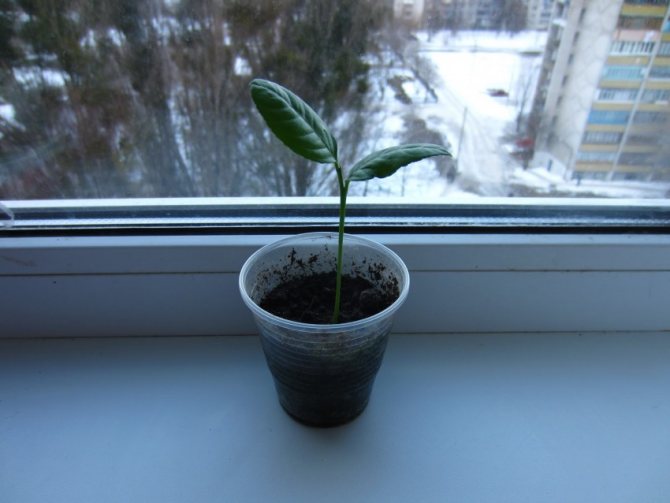

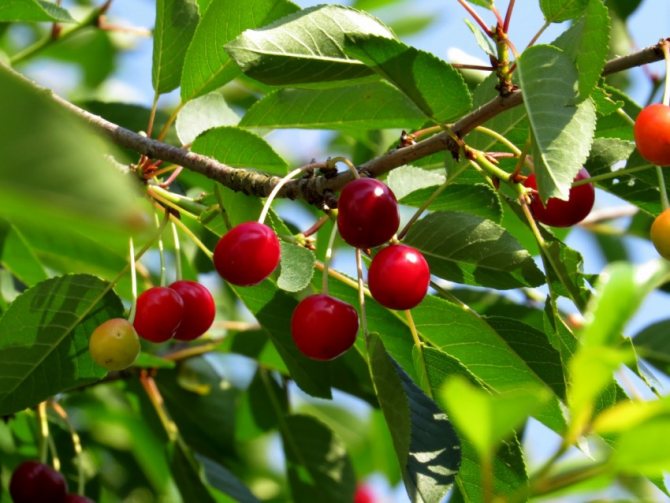

How to propagate cherries - growing, reproduction in autumn, spring and summer. 135 photos of care options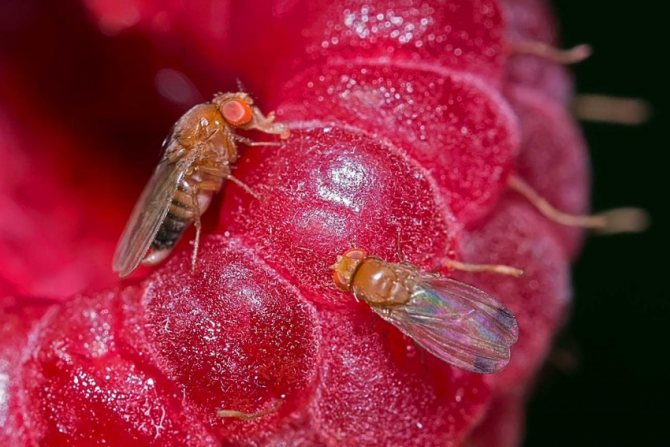

Raspberry Pests: An Overview of Raspberry Pests and Diseases. Photo and video treatment, methods of raspberry pest control (115 photos)
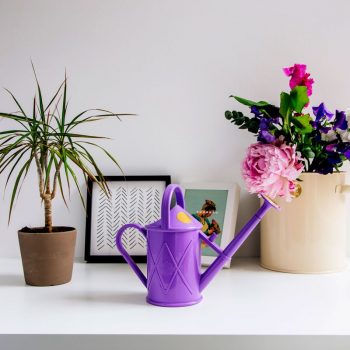

Watering indoor flowers: how to water flowers correctly? Expert advice on the frequency and method of watering various types of home flowers (135 photos)
If you have a large lemon tree, an oak pot or pine container will work for you. They are resistant to bacteria absorption.
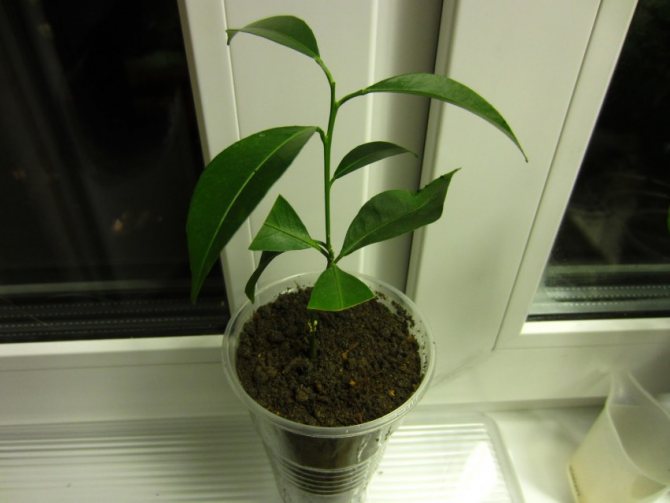

But before replanting the plant, the pot should be burned from the inside. In this case, a carbon deposit forms on the walls, which disinfects the container and protects it from decay.
How to transplant a lemon?
When seedlings up to 15 cm high grow from the planted grains, you will need to transplant them into another container. It should be 5 cm larger than the previous one. In such a pot, the root system will quickly fill the space. You should not transplant the lemon immediately into a large container, since moisture will over-acidify the soil. It is better to plant lemon seeds at once in different containers. Then you will not need to do frequent transplants. And the lemon will feel better and will not damage the roots. If, nevertheless, you are going to transplant a citrus plant, you must adhere to the transshipment method. A new pot also needs moisture holes and good drainage. The diameter of the dishes is taken 3 cm more than the previous container. And the composition of the soil should be the same as when planting the grains. In shops you can buy a garden soil mixture with humus. When transplanting a lemon, its root collar should be located at ground level.
What kind of soil is right
Experienced flower growers know how to transplant lemon in spring correctly.Great importance should be given to the choice of the substrate. You can buy it at the store, or you can cook it yourself. To do this, mix 3 parts of disinfected soil, 1 part of humus, and 1 part of river sand. If you do not want to spend your time and effort preparing such a mixture, buy a ready-made substrate with a neutral reaction designed for growing a lemon tree.
It is good if you prefer fertilized soil: for the first time after transplanting, you will not need to feed it with nutrients. Six months after the excavation, add organic or mineral fertilizers to the soil. The main thing is the absence of chlorine in such mixtures.
How to fertilize?
If you do not constantly apply top dressing, you will not see a good harvest of citrus fruits. For indoor lemons, there is a complex fertilizer on sale. You can also dilute ash with water and add it as a top dressing for lemon. The infusion is prepared for 2 days. Good fertilizer is obtained from manure and water (1x10). One feeding is enough for young trees for 45 days. An adult lemon is fertilized every two weeks in the spring and fall. In the fall, a lemon that is warm should be moistened once every 40-45 days. If the tree is in a cool room, it does not need feeding. It is worth knowing that fertilizers are applied to wet soil. Therefore, before the procedure of vitamin supplements, the plant must be watered with ordinary settled water. Thanks to fertilizers, fruiting will be faster. But it will be necessary to increase phosphate supplements and decrease nitrogen ones.
Tips & Tricks
If you are using purchased soil for transplanting, additionally pour sand and vermiculite into the pot - the soil will become more porous and will retain a sufficient amount of moisture.
There is no need to mix the components with the soil - they should be at the bottom of the container and be 1/5 of the height.
Ordinary birch charcoal will help prevent the development of fungus in the substrate - a small amount is simply mixed with the soil. A similar effect is exerted by crushed pine bark, which is poured over the vermiculite in a centimeter layer.
In the case when the earth in the flowerpot has sunk, and it is too early to replant the lemon, you just need to add fresh soil to the desired level. The tree will receive additional nourishment and grow better.
A lemon adapted after transplanting needs the same care. Top dressing begins six months later, using mineral or organic fertilizers without chlorine.
How to prune indoor lemons?
You need to form the crown of a citrus mini tree regularly. This can be done in two ways. If the lemon is grown as an ornamental plant, it is necessary to carry out the pruning so that a small bush forms. To get a good harvest of fruit, you must achieve a large presence of leaves and shoots. It is necessary that they form quickly. The main method of this formation is pinching. It begins to be carried out when the sprout reaches a height of at least 20 cm. After that, the distance from the previous place should be 15 cm, while at least 4 buds from which the main shoots grow are needed between the clothespins. Each subsequent branches should be 4-6 cm less than the previous ones. Then the crown will be compact and beautiful. Broken shoots and those that will grow into the crown will need to be removed.
Preparatory stages
Preparing for a transplant takes the most time and is perhaps the most important procedure. The further success of all work depends on its correct implementation.
Plant preparation
Before transplanting, the lemon tree should be removed from the old pot, and the root system should be examined. If rot is detected, trim the diseased roots and disinfect them. Excess twigs on the plant must also be removed so that they do not take away vitality, and the seedling takes root more easily.
Pot selection
What kind of pot is needed for growing lemon so that the seedling feels comfortable and easy to care for? Preference should be given to containers with a flat bottom, pots are not suitable for these purposes. The material from which they are made can be absolutely any, there are no restrictions in this regard. The size of the pot for indoor lemon is chosen 4 cm larger from where the plant grew earlier. A mandatory requirement is the presence of drainage holes. It is better if the container is small in height, but wide.
See also
How to properly graft a lemon at home so that it bears fruitRead
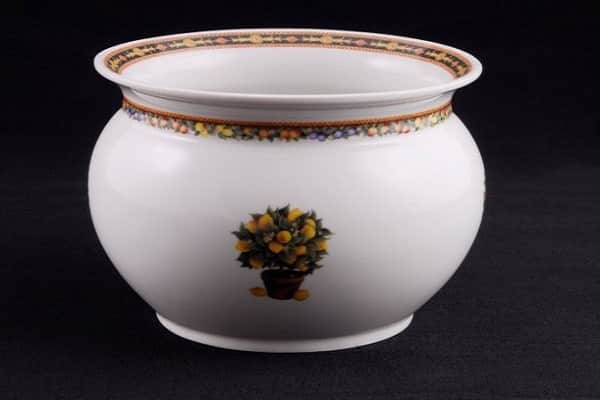

Required soil and drainage
Expanded clay and river sand are used as a drainage layer for lemon. It is preferable to purchase ready-made soil for growing citrus plants. It already contains all the necessary components and trace elements.
Diseases and harmful insects
Very often, many breeders of indoor citrus fruits on plants can see yellowed leaves, which will soon fall off. The reason for this may be: insufficient nutrition, dry air, high room temperature. Lemon leaves will also fall off if the plant becomes infected with a spider mite. Such drugs as Fitoverm, Akarin will help to overcome it. If you notice that your lemon has begun to shed its leaves, you need to review all of the above points and think about whether all the normal conditions are created for a citrus plant.
Falling leaves can occur due to improper transplantation. If the roots of the plant are damaged. leaves will fall. It is necessary to transplant the lemon into a new container in the first years every 3 years.
Threats to indoor citrus fruits are: scale insects, aphids, mealybugs, whiteflies. In apartment conditions, it is better to get rid of them using natural means. You need to apply an infusion of garlic. To do this, it is crushed and infused in water for 5 days. But if there are a lot of pests, you will have to use chemicals.
I recommend reading:
Tips for choosing cookware
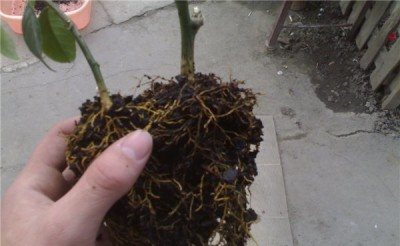

- Wrap a white, translucent pot with a dense cloth, otherwise the soil will overgrow with moss - the plant will suffer.
- Before using the ceramic pot, soak it in water for 2-3 hours to keep it moist and not draw water from the soil.
- The plastic container does not require additional processing. But the drainage layer in it must be larger to avoid waterlogging. Clay absorbs excess liquid, but plastic does not.
- Wooden tubs recommended for tall specimens should be made of pine or oak. Other types of wood will rot at high speed, and you will have to transplant at the wrong time. The tub is fired from the inside so that a layer of charcoal forms on the inner surface. It will disinfect the container and at the same time increase its resistance to decay.
Preparing the ground for the plant
Land for planting can be bought or made on your own. To do this, we need leafy earth, washed sand, humus and sod land, which should be twice as large, in relation to other components.


Before use, sift the mixture from lumps and excess debris. We plant seeds in loosened soil to a depth of no more than 2 centimeters.
For planting, we use small plastic containers with pre-drilled holes.
After that, we put the planted seeds in a warm place where the temperature does not fall below 18 ℃, but you can also make a small greenhouse.
In such conditions, they should stand for three months. After the first leaves appear, the lemon can be transplanted.
Lemon properties - harm and benefit
Useful properties of lemon
In the popular literature, the beneficial properties of lemon have been described many times. But since it is always pleasant to write about good things, we are ready to once again highlight the topic "Harm and benefits of lemon" in detail. So, what is the use of lemon? Its fruits contain:
- citric and malic acid;
- trace elements iron, potassium, copper, manganese and iodine;
- Sahara;
- pectins;
- flavonoids and phytoncides;
- fiber;
- vitamins A, B, P, D, C and group B - B2, B1, B9.
Due to the presence of these components in lemon fruits, it has:
- tonic;
- refreshing;
- antipyretic;
- bactericidal;
- strengthening action.
In addition, lemon juice is a source of citrine, which, in combination with vitamin C, has a beneficial effect on redox processes, metabolism and strengthens the walls of blood vessels.
With its strong bactericidal effect, lemon helps the body to cope with the flu, but for this it must be consumed with tea made from mint, plantain, horsetail and sage.
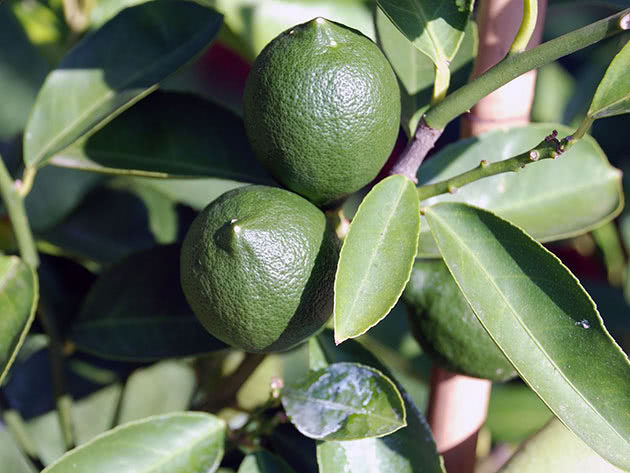

Restoring digestive processes, lemon helps to remove toxins and toxins from the intestines, helps to cope with infections of the respiratory tract and oral cavity, relieves or alleviates migraine pain, eliminates rashes and boils on the skin. In addition to the listed advantages, it must be said that lemon is a good diuretic.
Despite the sour taste, lemon is able to lower the acidity of gastric juice. Lemon juice and its peel are excellent antiseptics, and the leaves of the plant are successfully used to lower the temperature. Due to the high content of vitamin C, lemon has a strengthening effect on the immune system.
Lemon is part of many medicinal preparations that relieve inflammation, kill germs and worms, heal wounds, strengthen the body and reduce the manifestation of sclerosis. The use of lemons for food is indicated for atherosclerosis, lung diseases, poisoning, vitamin deficiency and hypovitaminosis. It is useful even for pregnant women.
Baths with the addition of lemon juice relieve sweating and tired feet, rinsing the mouth with lemon juice strengthens the gums and tooth enamel. If you regularly eat lemons, diseases such as colds, tonsillitis, tonsillitis, vitamin deficiency, urolithiasis and cholelithiasis, gout, atherosclerosis and diabetes mellitus will not pose a danger to you. And this is not a complete list of health problems that the yellow sour fruit will relieve you of. Isn't that a good enough reason to grow indoor lemon at home?
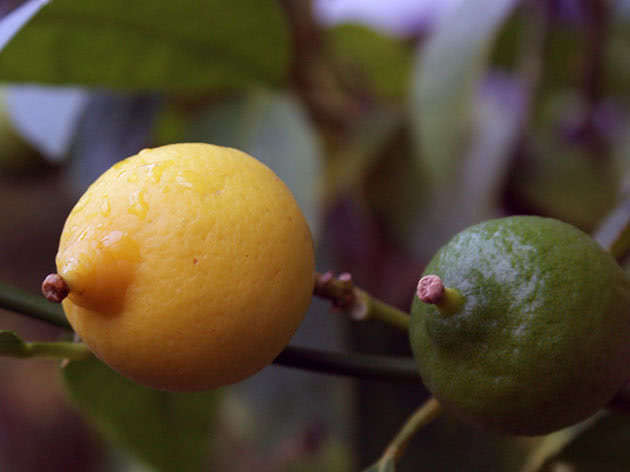

Budding method
On your plant, we make an incision on the trunk in the form of the letter T, 1 cm wide, 3 cm long.
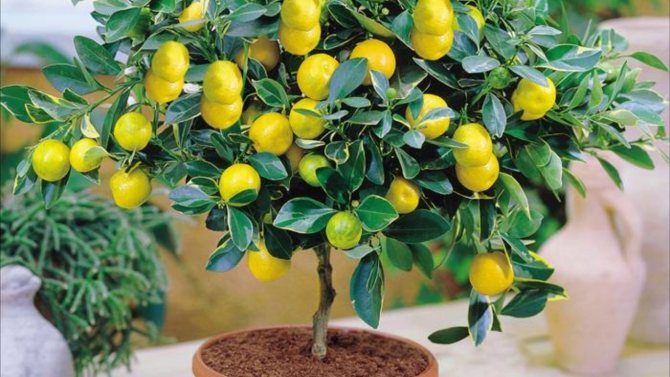

For this we use a special knife. Fold back the bark and insert a pre-cut kidney from the grafting cuttings there.
We close the bark and rewind it with a special tape, while leaving the bud visible.
After three weeks, the stalk will disappear, after which we remove the bandage. The fruits will appear in the second year.
Transfer
The tree is grown only in a properly selected pot, so as it grows, transplanting into a larger container is required.
Attention! Too large a pot will cause root rot.
The container size increases gradually, for which the growth of roots is taken into account. The transplant is carried out in a standard way, for which an earthen lump is pulled out of the pot, transferred to a prepared container. After that, the citrus culture is exhibited in its original place. A change in environment negatively affects development.
Growing lemons from seed
Lemon can not only be bought in a store already grafted, but also grown from a seed, and eventually grafted on its own.
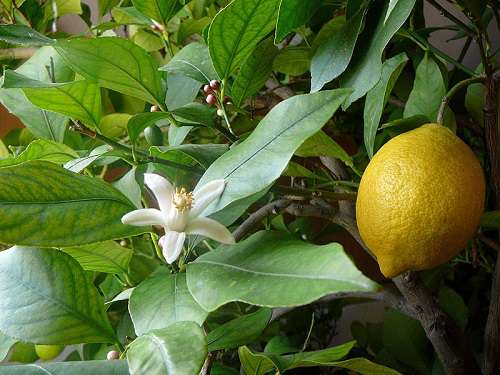

For real gardeners, this process will be the most entertaining.
The most important thing when planting is the choice of seeds, it is necessary to remove seeds from the fruit and choose 10-15 of the largest ones among them, this guarantees a healthy seedling.
Before planting, we do not dry the seeds, but rather soak them in epine, for this we make a solution by adding 4 drops of fertilizer to 100 ml of water. After the seeds stay there for a day, we plant them in the ground.
Correct flushing of leaves
Conditions growing lemon and care it is followed by washing it as needed.It helps to get rid of dust and possible pests, as well as unclogs the pores of the plant and refreshes it. How to do it right?
First you need to wrap the pot in a plastic bag so as not to flood the earth. Then put it in the bath and wipe all the leaves with water and laundry soap diluted with it. Then you need to rinse the plant with a gentle pressure of a warm shower.
It is important to make sure that a lot of water does not get into the ground (even wrapping the pot with cellophane does not make it permissible to shower directly from above). It is advisable to tilt the pot so that the water flows directly into the bath, and not down the barrel.
Also, in order to avoid pouring lemon, you need to pause in watering before washing, waiting for some drying of the earth. Then the water that gets into the pot will not be superfluous, but will be perceived by the plant as watering. But you cannot constantly water the lemon in this way, because it requires settled water with a minimum amount of chlorine and other elements that are harmful to any indoor greenery.
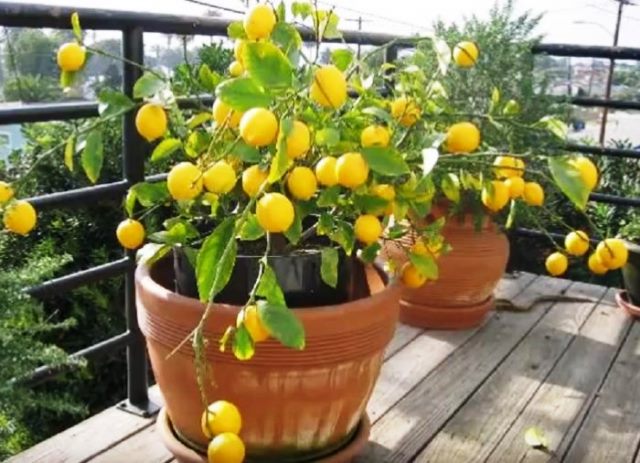

Description of the culture and the best varieties
Lemon is a Mediterranean guest but was born in India. From there, the beautiful tree got to the countries of America and Africa. In the southern regions, whole groves of these picturesque trees can be found everywhere. Not found in the wild. Citrina pulp is saturated with acids, vitamins and microelements:
- citric acid - the main constituent of citrus;
- pectins, flavonoids, phytoncides, essential oils - concentrated in the peel, as well as in the pulp;
- vitamins C, B, D, PP;
- ascorbic acid, tocopherol, riboflavin and others;
- trace elements - iron, boron, copper, fluorine, zinc, manganese and others.
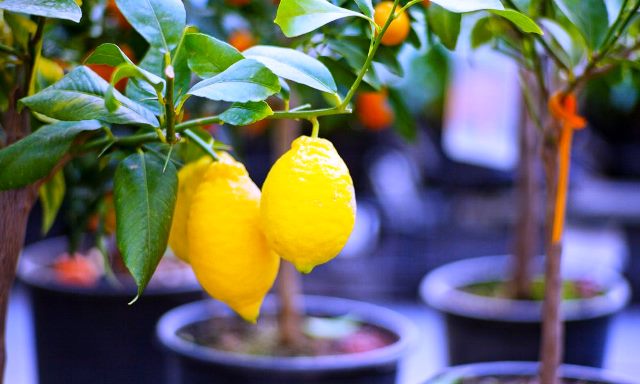

For growing at home, only specially bred dwarf varieties are suitable, well leafy and abundantly fruiting. To grow a real lemon tree on the windowsill, you can go in three ways:
- Buy a sapling in the agricultural sector.
- Plant a seed in a pot.
- Root a stalk from another adult plant.
The easiest way is to go the first way, the more difficult - the second. But in any case, care is required for the grown lemon.
1. Seven Secrets of Success:
| 1. Growing temperature: the flower reacts well to daily temperature drops - if in the daytime in spring and summer the air temperature can be 18 - 24 ° C, then at night it is worth lowering the temperature to 13 - 15 ° C. In autumn, the plants are gradually transferred to rest mode, which is lemon should be held in a cool room at a temperature of 12-14 ° C. |
| 2. Lighting: lemon is very photophilous and needs direct sunlight every day - morning and evening, for 5 - 6 hours. In autumn and winter, the maximum possible lighting. A light shade will only be needed during the hottest daytime hours in summer. |
| 3. Watering and humidity: Dry the topsoil about 3 - 5 cm thick during the spring and summer, reduce the frequency of watering in the fall and winter, especially if the plant is kept in a cool room. Once a month, mix a few drops of lemon juice or grains of citric acid into the water for irrigation. Air humidity is high. |
| 4. Pruning: sanitary - removal of old and diseased branches, shaping - necessary for the formation of a dense and lush crown, as well as for the onset of flowering and fruiting. |
| 5. Priming: must have an acidic pH, perfectly nourish the plant for abundant flowering and fruit formation, and also allow moisture and air to pass easily to the roots. |
| 6. Top dressing: in the warm season - 2 times a month, in the middle of autumn, when providing a cool dormant period, feeding is suspended until spring. If the lemon is grown throughout the year at normal room temperature, monthly fertilizing is required during the winter months. |
| 7. Reproduction: cuttings, grafting, sowing seeds - seeds in the spring. |
Botanical name: Citrus Limon.
Homemade lemon - family... Root.
Homeland of lemon... China
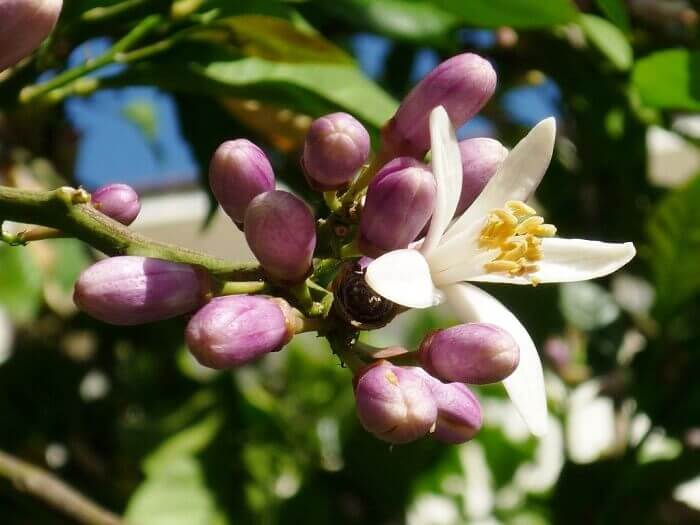

Description. Lemon is a perennial, evergreen, branched tree with thorny branches.
Leaves oblong-oval, dark green, glossy, fleshy. The leaves contain essential oils and, when damaged, give off a pleasant citrus scent.
Flowers small, white, fragrant, solitary or collected in inflorescences - small clusters at the tops of the shoots.
Fruit round, juicy, green, turn yellow when ripe. Fruits ripen for a rather long time - about 9 months, so at the same time, flowers, green and yellow lemons can be found on a lemon tree.
An interesting feature is the growth of the lemon tree - it immediately releases young twigs with small leaves, and not individual leaves.
The best varieties of lemon for home growing are: Pavlovsky, Meyer, sometimes Genoa, Novogruzinsky and Vulkan trees come across.
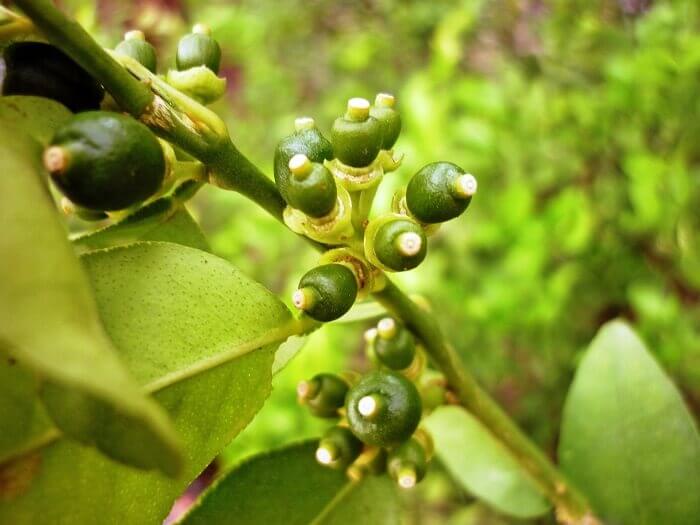

The size... Indoor lemon grows up to 2 m.
Care at different times of the year
In the spring, the tree wakes up, so active growth begins. At this time, he needs a lot of sunny color, so it is advisable to use lamps. In warm weather, you can take it outside. The room in which the tree is located must be ventilated, since air flow is required.
In the summer, it is advisable to expose the plant to the street or even to dig it in the country.
In the fall, the tree returns home, and it must be carefully examined, since when pests or diseases are found, appropriate preparations are used. A warm shower is arranged, and the leaves are well washed.
Before wintering, watering gradually decreases and the amount of applied fertilizers decreases. In winter, a dormant period sets in, so a cool temperature is maintained, and watering is also reduced.
Beneficial features
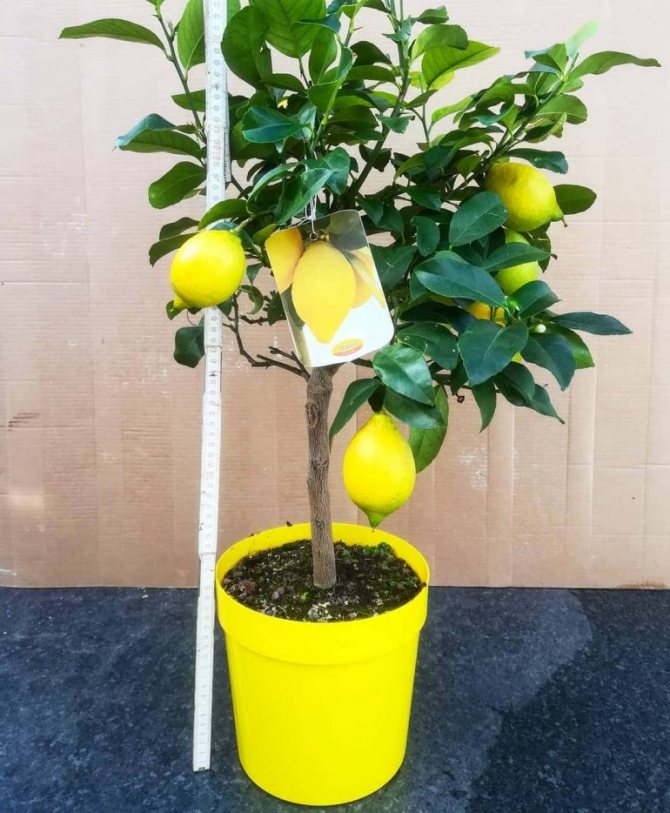

Lemon tree (Citrus limon). Photo
A treasure trove of valuable substances used both in cooking and in medicine. Lemon essential oil is an excellent bactericidal and wound healing agent. Stops bleeding, removes headaches, has a beneficial effect on the psyche, eliminates skin problems. In addition, this oil is used for the manufacture of cosmetics, perfumes, and medicines.
Rules for growing lemon fruits
The development and ripening of fruits on a lemon tree takes 7 to 9 months. During this period, several rules must be observed:
- avoid temperature changes;
- do not turn and once again do not move the flower pot;
- do not cut off the stems and leaves.
The foliage of the tree plays a very important role in the ripening of lemons. It is she who provides them with carbon dioxide and nutrients. It is believed that at this time, at least ten leaves should grow on the plant for each fruit.
Ripe lemons are picked one and a half to two months after formation. If not harvested on time, the skin will become thick and rough and the flesh will dry out.


What to do if the plant dries
The lemon tree usually dries out with improperly selected soil or over-watering, as this leads to root rot. When transplanting, the rules of a gradual increase in the size of the container must be taken into account, otherwise the soil will quickly turn sour.
Sometimes the plant dries up when exposed to pests that are located on the trunk or in the roots. Frequent movement of the pot from one place to another has a detrimental effect. If the tree is watered too rarely, then it simply dries up from lack of moisture.
To combat drying, the reason is determined, after which pest control drugs are used, a special fertilizing for citrus fruits is introduced, or the plant returns to its original place.
What to do if the leaves have fallen
The reason for the dropping of leaves is poor lighting. The lemon tree is depleted, so it cannot provide all the necessary nutrients to the existing leaves.
Therefore, if the leaves begin to fall, then the pot is immediately exposed on the windowsill on the south side so that the plant can receive a lot of light. In cloudy weather, artificial lighting is provided.
Why are there no fruits
Lemon trees can bloom profusely, but the ovaries fall off without fruit. There are various reasons for this:
- no cross-pollination, which you have to do on your own using a cotton wool disc or a regular brush;
- the impact of pests, since even the slightest infection leads to a slowdown in growth and the absence of fruits;
- the plant blooms even in winter, therefore, due to the lack of dormancy, the strength for fruiting is not restored;
- abundant flowering, which becomes an obstacle to the appearance of fruits, therefore it is necessary to get rid of numerous flowers on your own;
- lack of feeding.
After determining the exact cause, it becomes possible to cope with the lack of fruiting.
Lemon varieties grown at home
However, not all types of lemons are intended for home growing. In order for the tree to take root well, blossom and bear fruit, you should choose one of the specially bred varieties:
- Mayer, Meyer or Chinese dwarf are the most common, unpretentious species. It is distinguished by its small growth (up to 1 m), dense beautiful foliage and small, but sweet and juicy round-shaped fruits.
- Novogruzinsky and Kursky are tall (up to 2 m) varieties. They require more attention and care. They bear fruit more often. The fruits are large and fragrant.
- Pavlovsky is an unpretentious bushy plant of medium height (about 1.5 m) with several trunks.
- Maikop is a medium-sized (1.5 m) variety with thin-skinned elongated fruits.
- Eureka is a fast growing species. Produces fruit with a thick skin and a very sour taste.
- Genoa is a dwarf, high-yielding variety. Differs in tender pulp and aromatic zest without bitterness.
Care rules depending on the period
The tree needs specific care, taking into account the period, which can be represented by flowering, dormancy or fruiting:
- Bloom. At this time, the tops of the shoots become purple. Large flowers appear in spring after the first bud appears. The flowering period lasts about two months. Only after the petals have fallen off does the fruit set. Throughout the year, one tree may contain small fruits, ovaries, buds and flowers. You do not need to pluck the inflorescences, as they become ovaries. During flowering, standard care is provided. The plant is protected from drafts, and is also regularly sprayed. There should be about 10 leaves per inflorescence. The rest of the ovaries are removed, otherwise a lot of small and tasteless fruits will be obtained.
- Fruiting. The fruit ripens after setting for 200 days. During this period, the plant needs nutrition and good watering. The number of fruits usually does not exceed 8 pieces. During this period, no specific care is required, therefore, it is enough only to remove the fruits in a timely manner.
- Peace. It falls on the winter period. It is necessary to create optimal conditions for the tree to bloom and bear fruit fully during active growth. Therefore, the plant is kept at a cool temperature. Flowers and shoots are removed before the dormant period. The temperature ranges from 12 to 17 degrees. Minimum watering is required, but the soil does not dry out. Spraying is carried out several times a week.
With proper care at every period of time, the rapid development of the lemon tree is ensured.
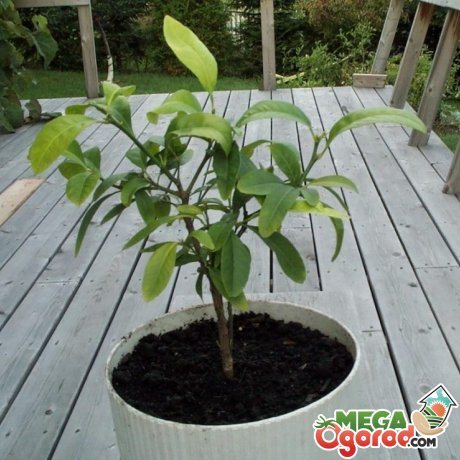

Homemade Lemon Care: Warm + Light + Consistency
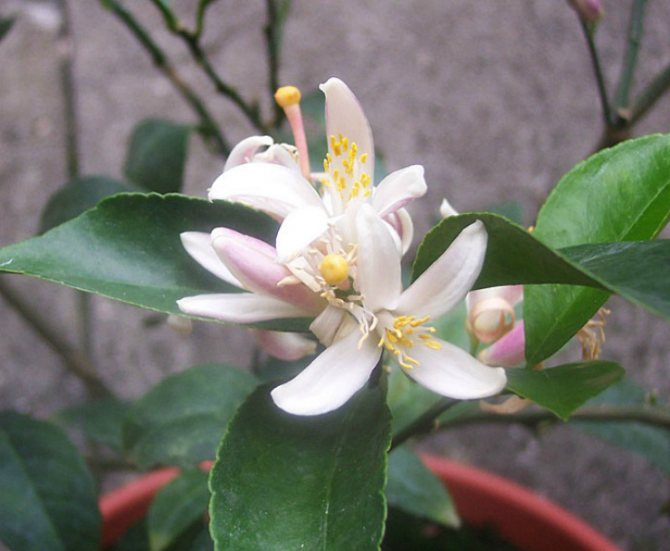

The indoor lemon is distinguished by its wayward character, which is manifested in its exactingness to the conditions of detention.
In particular, he does not tolerate sudden changes in temperature, humidity and reacts painfully to a draft.A moderately humid and warm microclimate and abundant lighting are essential for the well-being of your green pet.
Just don't place the pot in direct natural light, as lemon also doesn't like to fry in the sun. For example, you can put a plant on a south or southwest window sill and shade it with a tulle curtain or gauze.
An interesting fact - the lemon does not like the neighborhood with strong-smelling house flowers, so do not put lilies or rhododendrons next to it.
In autumn, winter and early spring, homemade lemon needs additional lighting using LED or fluorescent lamps (at least 40 watts). On average, it is enough to turn on the lamp for 3-4 hours a day (2 hours in the morning and 2 hours in the evening). However, it should be borne in mind that a lemon plant needs at least 8 hours of sunlight or artificial lighting in winter and from 10 to 14 hours at other times of the year.
Lamps are installed at the rate of 2-3 pieces per square meter. Moreover, they should be located at least 40-50 centimeters above the level of the highest branch.

